
INTRODUCTION | PAGE 3
GALLIFREYAN GUARDIAN | PAGE 4
PUBLIC IMAGE | PAGE 6
THE RESTORATION TRAILER | PAGE 9
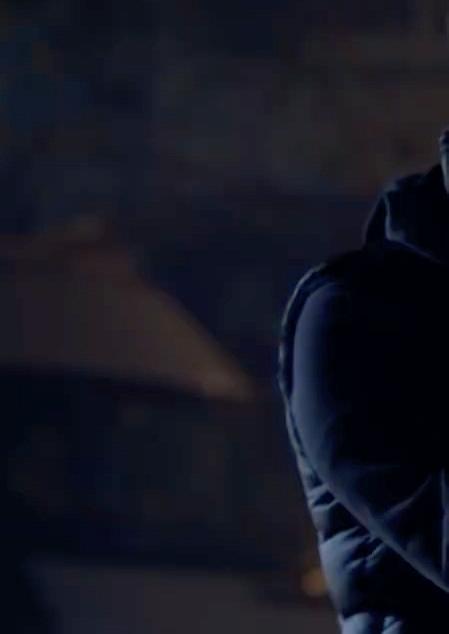
MERCHANDISE RELEASES | PAGE 10
ADVENTURES GO FOURTH | PAGE 12
THROUGH TIME AND SPADE | PAGE 14
MATT MOIR | PAGE 20
AFTER AFTER WHO | PAGE 28
ENDGAME RETROSPECTIVE | PAGE 32
REWIND TO 1990 | PAGE 35

PAGE 2
SEPTEMBER 2022

MEETING MATT...
Back in October, I have the brillaint experience of travelling down to London and meeting, my former co-writer on WIDWWA, Matt Moir. Now you might ask where the logic of travelling south for three hours, when Matt lives seven hours north of me, but it was because we were both headed to the same event, the BFI's screening of The Time Meddler. It was a great day and after me and Matt sat down to talk about WIDWWA in a hotel room for 90 minutes. I had intended this interview to be video on the DDWF channel however the video and sound quality didn't come out quite as intended, so I decided to keep the recording for a time when the Magazine wasn't as busy and then publish a transcribed version there. I decided that Issue 11 and 12 would do the job, as there wasn't much going on apart from an episode of Adventures. Now considering this issue is 54 pages long... perhaps I made an error of judgement.
However, considering Matt is plastered across the cover, I couldn't exactly renege on this promsie, especially as I announced it in the last issue. So please, enjoy this huge edition of the WIDWWA Magazine and to all the podcast listeners... maybe think about doing this one in a few sittings.
I do also want to give an update on the Elyisum book's second edition that I announced a couple of months ago. I'm just finishing off the final cast lists for Season 5 and after that it should be pretty much good to go so keep a look out for that!
We've also got a great new poster for the Restoration, which you'll see more of in the Gallifreyan Guardian, so you can have a good guess at what the front cover of next month's issue will feature most promimently. If you haven't remember, next month is October in the WIDWWA-verse so we will be covering the Centenary episode, The Restoration! So look forward to that, it's

a big one!
Unfourtantly due to the size of this issue, Issuu, the usual provider for the magazine, has rejected its publication, due to the fact that its free plan only allows Magazines of 50 pages or less and this magazine originally ran to 54 pages. So if you're reading this, then you are reading a cut-down version of the Magazine, removing 4-pages. The first is WIDWWA News and WIDWWA Views which is gone. This section was rather bare this week and made the most sense to be cut. The second is a lovely, but late addition to this edition, by WIDWWA fan, Jamie Smith, who wrote about an article about Finding Ian Fraser. This is a really wonderful feature but sadly it couldn't be included here. If you want to read the full version of the magazine, there's a Google Drive link on the WIDWWA Twitter Page. WIDWWA
PAGE 3
Trailer for Doctor Who: The Restoration Released!


The Official Trailer for Doctor Who’s, so called, “BBC Centenary Special”, which is actually the 7th episode of its full 13-episode 56th season, has been released.
The trailer lasted for 1 minute and 51 seconds in total and was released on the Official Doctor Who YouTube Channel at 7pm on 23 September 2022. At the same time, on BBC One, just prior to the Strictly Come Dancing 2022 Launch Show, a shortened 60-second edit of the trailer aired.
Outside of the UK, as has
become standard practice, Paramount+ uploaded a version of the trailer that swapped out BBC branding for their own and changed the date from “23 October'' to “October 23”. A full transcript of this trailer can be read on Page 11.
The trailer itself contained a number of reveals: firstly, the fact that Sandra Armstrong and Lou Madison, former companions of the Ninth and Tenth Doctors, would be making a surprise return in the special. Both Sandra and Lou died in the series, so their resurrection, as a result of the Restoration, which took place in the closing moments of the pre-
vious story, The Daleks’ Master Plan, makes a lot of sense. The trailer also revealed the fact that the Cybermen are to be the main villains of the episode.
Prior to this trailer, it had been announced that Shelley King as Sally Brennen, Daniel Adegboyega as Pete Fletcher, Jane Wymark as Annie Downes, Bill Nighy as Andark and Ronan Summers as The Intendant were returning, and indeed this trailer showed quite a bit of footage of each of them reprising their much-loved Doctor Who characters.
Finally, the release date of the episode was revealed to be Sunday 23 October 2022, exactly one month following the release of this trailer, and 133 days after the conclusion of The Daleks’ Master Plan in June. WIDWWA
gallifreyan
PAGE 4
Poster for The Restoration Released
Inaddition to the trailer for The Restoration, the BBC & Paramount have released a poster for the episode.
The poster features all three Doctors appearing in the special together, with Samantha Bond's 14th Doctor receiving the most promimence appearing in the top centre, with the 16th and 11th Doctors below her.

WIDWWA
The New Renegade announces Premiere Date
Paramount+ have announced the start date for Doctor Who: The New Renegade - Season 3 as 6 November 2022.
Originally, the season was announced as airing in September 2022, before being pushed back to October. Now the season will be released from 6 November, for six episodes, until 11 December 2022 before taking a mid-season break and then returning in February 2023 for the final four episodes of the season. It is currently unknown why Paramount+ have drastically changed plans in such a manner.
A full trailer has yet to be released for the season, however a short 20-second Teaser Trailer was screened at San Diego Com-
Principal Photography begins on 60th Anniversary
Aftermany delays and setbacks, principal photography has finally begun on Doctor Who's 60th Anniversary film, currently known as Doctor Who VIII.
ic Con and released on YouTube back in July. It's expected one will be released soon.
WIDWWA
Doctor Who: Adventures Series 5 & 6 to be merged
Insurprising news, Doctor Who: Adventures Series 5 and Series 6, which like with Series 3 and Series 4, are being produced as one big production block of 20 episodes, and then aired in two separate runs, are in fact, being merged and will just air as Series 5.
Mal Young says: "After taking on board viewer feedback, we've taken this decision to streamline the show's output."
Series 5 was announced as airing in January 2023 and Series 6 in September 2023... it is unknown when this new 20-episode run will start, but it's likely going to be later than January.
WIDWWA
The film, which recently acquired a new screenwriter, in the form of Adrian Hodges, is being directed by Mick Jackson, who directed Doctor Who stories, Friends on a Train, God's Familiars, Homeland & Vajahnari's Curse, and also has an incredibly successful film career.
The film is being shot mainly, at WhoStudios' Lambert Centre, and is the first major production to be produced there, following the lower-budget Doctor Who: The Time Meddlers in June. Shooting for the film will also take place elsewhere, including in North America and around the world.
All that is known about the film's cast is that Ace Bhatti will star as the Doctor. It is very likely that more will be announced, very soon, as filming moves onto location.
The film is a co-production between Paramount Pictures, BBC Film and WhoStudios and is set for release on 24 November 2023.
WIDWWA
guardian PAGE 5
PUBLIC IMAGE
ToffA reports on the UK television viewing figUres for DoCtor who: seAson 35
After observing Season 30’s ratings based upon newspapers from 1993 showing the top 30 from each of the four channels, we’re going to get more accuracy now, as we take a look at Season 35’s viewing figures courtesy of BARB. We’ll continue going through the viewing figures for Doctor Who and most of its spinoffs up to the present day (aside from any that have already been reported, or in the case of Adventures and The Time Meddlers, due to few reported ratings for most other channels since 2018, will unfortunately be skipped).
To Season 35 now, as we explore how Doctor Who fared in a different television landscape almost 25 years ago, between November 1998 and February 1999: where linear television was king, the internet relied on dial-up, and digital television had just launched in the UK. We’ll again go through the consolidated figures, how it ranked for Saturday and across the week for BBC One, and overall across all channels for the week as well as what competition was on ITV.
sion ratings have started to decline. This puts Doctor Who in a good light to kick this season off. But considering that this was meant to be the beginning of a new era, it seems relatively underwhelming compared to how Season 34 started out with 9.7 million. Perhaps viewers were scared about how different Doctor Who would be under the leadership of David Renwick, and with financial support from Paramount with the razmataz of changes behind the scenes. It could also be due to the season starting relatively later than normal, with viewers not aware of the season starting in November, which is usually the beginning of a peak time for television where the biggest ratings start to draw in. Fortunately, these fears were put aside as ratings managed to go up as the serial went on, and viewers began to warm to the new format.
urdays in 1986). Similarly, Noel’s House Party, which was the BBC’s biggest Saturday night show and followed Doctor Who, had undergone a similar fate. Big in 1993, bust in 1998, and some news about the show comes out during Season 35’s airing, which we’ll uncover later.
We initially saw statistics similar to these earlier with Season 30 when it began during the summer. Only this time, it appears to be in the Autumn, so even five years on, televi-
Competition on ITV was Gladiators for all three parts, which managed roughly 6.5 million for the first two parts, but grew to seven million for part three. A far cry from almost double what it managed in its heyday as we’ve seen from last time. Surprising when you consider that when Doctor Who returned to Saturdays in 1992, such figures as seven to eight million were seen as relatively poor (though not as bad as the four to five million it achieved when last on Sat-
The Hail Mary averages out at figures of 9.23 million, and 30th in consolidated terms. Let’s see if things get better as we travel into the future, whether by a week, or a few billion years.
Whilst we have a small slip, there hasn’t been as much of a major change to the rankings, placing just outside the top 30. Gladiators fought against the Doctor on ITV for the final of what would be its penultimate series, but the Time Lord was the true winner in the ratings. Average figures are down by 100k and
PAGE 6 The Hail Mary Ep Date Rating Ranking Day BBC1 7-Day Consolidated 1 21 November 1998 9.08m 3rd 16th 31st 2 10 July 1993 9.22m 3rd 15th 29th 3 17 July 1993 9.39m 4th 15th 30th
"[The] competition was Gladiators...
The End of the World Date Rating Ranking Day BBC1 7-Day Consolidated 12 December 1998 9.13m 3rd 15th 31st
A far cry from almost double what it managed in its heyday as we’ve seen from last time..."
one consolidated placement down for the rankings.
but still the same consolidating ranking. Doctor Who appeared to bow out of 1998 on a pretty good footing. How will it fare into 1999, as perhaps the most anticipated serial in its history airs?
this momentum be kept for the rest of the season?
With Gladiators over, Doctor Who faced some new competition. The majority of the episode was up against the first Record of the Year, an annual live show where viewers vote to determine which chart single was the best of the year, with a voting process similar to Eurovision, with points determined from ITV regions across the UK. This ran until 2005, at least on television. Ratings for it were very slightly up against the Gladiators final, but was still nearly two million behind Doctor Who. The last few minutes were against Blind Date which provided stiffer competition, but narrowly lost out.
The second part did face somewhat of an uphill battle, especially as the episode went out on Boxing Day. It wasn’t really a festive special, and many popular shows aired during the Christmas period, which explains the dip in ratings and rankings. Furthermore, it also aired in the show’s latest timeslot at the time: 7:45pm, up against a showing of James Bond film, A View to A Kill, watched by two million less than Who, likely since it had aired multiple times over the last decade at that point and many more in the years to come. In spite of these factors, Part Two still held up relatively well.
The Robots of Time averaged at 9.04 million and 31st for the week, dipping slightly by 90k with the viewing figures,
To any sci-fi fan at the time, this was a big deal; two of the biggest sci-fi titans coming together for a special crossover, and clearly the spike in ratings prove this. For the first time since Revenge of the Master’s first part in Season 33, Michael French’s debut episode as the Doctor, it’s the first time that Doctor Who has been able to crack 10 million. Even better was the fact that the episode made it into BBC One’s top 10 for the week, placing ninth, and also made it into the top 20 overall, at 19th. It was even the most watched show on BBC One that evening, but still second for the night. Blind Date was the competition again, with a near two million viewers behind Who. The most watched show that evening was ITV’s hit gameshow Who Wants to Be A Millionaire?, which was watched by over 12 million at 8pm for its second series, with the show itself peaking going into the new millennium.
A Case for the Blue Box’s ratings are up 1.42 million from The Robots of Time’s average. It has also jumped up 12 places in its overall rankings. With such an increase in figures and publicity for Doctor Who, can
At first, the ratings tell us that it does, but not quite with the rankings. So what happened? Well on ITV’s part, they took advantage of entering 1999 with a second series of Millionaire which achieved strong ratings and helped some shows which aired around it increase their ratings, whether in anticipation, or staying put. From BBC One alone, Doctor Who was the most watched show of the evening behind Millionaire, and clip show TV Nightmares which preceded it on ITV. It was somewhat the opposite story with Part Two. Millionaire’s run had finished, giving BBC One the chance to strike back, and they proved so, with Casualty back on top, followed by comedy-drama Sunburn placing second for the night, and Doctor Who beating everything else on ITV, placing third. Competition wise, Blind Date remained its rival, airing in Who’s last 15 minutes; not quite managing to win over the charm of the viewing public. The other 30 minutes, were against the last 25 minutes of the 1991 film Father of the Bride, and a five minute news update. Both missed out on ITV’s top 30 with less than 8.9 million. GodEngine’s averages were 9.97 million and 34th in the rankings. They’re down by 0.51 million viewers and
PAGE 7
The Robots of Time Ep Date Rating Ranking Day BBC1 7-Day Consolidated 1 19 December 1998 9.21m 2nd 13th 24th 2 26 December 1998 8.87m 4th 23rd 37th A Case for the Blue Box Date Rating Ranking Day BBC1 7-Day Consolidated 2 January 1999 10.46m 2nd 9th 19th GodEngine Ep Date Rating Ranking Day BBC1 7-Day Consolidated 1 9 January 1999 10.02m 3rd 9th 33rd 2 16 January 1999 9.91m 3rd 14th 35th
15 chart placements. These statistics aren’t that bad when considering it follows on from A Case for the Blue Box, and the ratings are still higher than what the season started out with.
Steady going for one of the most critically acclaimed stories in Who’s history; going up seven places in the consolidated charts and placing second for the night in spite of a tiny drop of 90,000 viewers from GodEngine’s average. It’s competition for the first ten minutes was the gameshow Don’t Try This at Home, which failed to make it into ITV’s top 30 with less than 6.8 million, with the rest also winning out against Blind Date, albeit in a closer match.
follows Doctor Who. Well, in the week of Part One’s broadcast, the BBC announced they have axed the show after declining ratings. In fact, after Don’t Blink aired, a paltry 5.9 million stayed tuned to see what car crash of a show Noel Edmonds had planned. That’s almost four million viewers gone in an instant and below BBC One’s top 30!
Now for the finale, and a slip to start with. This could be put down to the afterglow of A Case for the Blue Box fading out, but the likely answer is the timeslot, as Doctor Who moved earlier to 6:25pm for Part One; again scheduled against Don’t Try This at Home. This was a minor setback, as the show moved back to 6:55pm for the other two parts, and we can see this as a benefit with viewers being drawn back in as Season 35 reached its conclusion.
Earlier, I said that a bit of news is announced regarding Noel’s House Party, which
Back to competition, the earlier timeslot may have slightly hurt Part Two’s performance, as Blind Date managed to pull ahead in the ratings. The last episode surge managed to prevent this for Part Three, as the season also ended on a high with it hitting BBC One’s top ten. Damaged Goods averaged 9.30 million, down 0.58 million viewers, and 28th chart-wise, a non-mover. Given Season 35’s ambition to be the beginning of a new era of Who, has this done good for the overall ratings? Well, I can reveal that with an average of 9.47 million throughout the season, this is up from Season 34’s 9.17 million; a 300,000 increase. It’s
average consolidated ranking was 29th. If we compare this to how Season 30 fared, ratings are up by 1.15m, and rankings up by eleven places. For 1998/99, this was pretty good going and proves to an extent that the revamp has been a success. As you may have noticed, compared to 1993, Doctor Who usually being third for Saturday, and winning the timeslot most of the time as opposed to tenth at worst, proves that not only was the revamp successful, but Saturday night television in the UK, and also ratings in general, were declining in the face of further competition from digital channels and the rising use of the internet. This is a key point which we’ll continue looking at in the seasons to come, with Season 36’s ratings upcoming, as we find out if it holds up from Season 35’s momentum to see Doctor Who out of the 20th century and the 1990s. In the meantime, if you’d like to discuss more on Doctor Who’s ratings so far in these articles, there is a Public Image discussion forum on the WIDWWA Discord server which you can join, which may include some additional ratings data exclusively on there.
WIDWWA
Don't Blink Date Rating Ranking Day BBC1 7-Day Consolidated 23 January 1999 9.9m 2nd 13th 28th Damaged Goods Ep Date Rating Ranking Day BBC1 7-Day Consolidated 1 30 January 1999 9.12m 3rd 15th 34th 2 6 February 1999 9.23m 3rd 13th 29th 3 13 February 1999 9.56m 2nd 10th 22nd
"For 1998 /1999, this was pretty good going and proves to an extent that the revamp has been a success."
PAGE 8
"That’s almost four million viewers gone in an instant and below BBC One’s Top 30!"
0:00 - Sara Kingdom: crawling on the floor, looks up and sees the Sixteenth Doctor...
Sixteenth Doctor: "The Restoration has happened, but it will only happen once, a single event..."

0:02 - The Sixteenth Doctor stumbles forward, visibly ageing…
0:03 - The Sixteenth Doctor holds a dying Sara Kingdom in his arms.
0:05 - The TARDIS dematerialises....
Sixteenth Doctor: "Every solution creates another problem..."
0:07 - The Sixteenth Doctor stands in the TARDIS.
Sixteenth Doctor: "Anyone and everyone who has ever lived is now alive."
0:11 - An overcrowded refugee camp on an alien planet…
0:13 - Inside the refugee camp, we reveal… Sandra Armstrong - dressed in rags...
0:15 - Pete and Sally stand in the TARDIS…
Sally Brennen: "This shouldn't be..."
Pete Fletcher: "Did I die for nothing?"
0:21 - On Earth, Lou Madison runs down a 40th Century street dressed in 16th Century clothing…
Lou Madison: “There is only one person who can help..."
0:23 - Protests and Riots: Signs reading "No Zombies" etc…
Lou Madison: "His name is the Doctor..."
0:23 - Another shot of different protests and riots on an alien planet.
0:24 - An unknown fleet of spaceships hangs in space…
0:26 - The Sixteenth Doctor looks worriedly at the scanner in the control room.
0:28 - The Cyber-Controller stands in the middle of a Cyber-Ship surrounded by an army Cybermen.
Cyber-Controller: "The Restoration shall last forever!"
0:32 - The Eleventh Doctor stands in front of his TARDIS.
Eleventh Doctor: "You asked for my help?"
0:35 - The Fourteenth Doctor stands in front of her TARDIS next to him.
Fourteenth Doctor: "Our help..."
Eleventh Doctor: "Same difference..."
0:37 - The Sixteenth Doctor stands in front of his TARDIS.
0:41 - “ON 23 OCTOBER”
0:43 - The Intendant stands on the soil of Gallifrey…
The Intendant: "The Restoration..."
0:45 - Sandra faces the Eleventh Doctor on Gallifrey.
Sandra Armstrong: "How dare you stand there and try and justify killing me..."
Sandra Armstrong: "Twice."
0:49 - The Sixteenth Doctor stands in the empty Panopticon…
Sixteenth Doctor: "You shouldn't be back... This is wrong!"
0:52 - The Sixteenth Doctor stands in Panopticon now full of Time Lords in ceremonial dress...
0:55 - A shot of an overcrowded alien city.
Andark: "This has to be reversed. People are suffering!"
0:56 - Wide Shot of Sandra's refugee camp.
0:56 - Andark speaks to the Sixteenth Doctor.
0:59 - The Sixteenth Doctor angrily points…
Eleventh Doctor: "I have lost so many... maybe there's a compromise here?"
0:59 - The Fourteenth Doctor rests his head in her hands.
1:00 - The Eleventh Doctor pleads with the other two.
1:02 - An army of Cybermen invade a planet.
Cyber-Controller: "We shall take advantage of this opportunity to rid the universe of pain..."
1:03 - A Cyberman touches a civilian as they scream.
1:03 - Cyber-mites embed into the skin.
1:03 - Cybermen walk out of a Cyber-Factory.
1:04 - Cybermen invade Sandra's refugee camp.
1:05 - On Sandra: Scared…
Sandra Armstrong: "I shall live as I have always lived... as a Bellonsion!"
1:06 - Sandra stands firm in front of the Cyber-Controller.
1:08 - The Fourteenth Doctor hangs out of the TARDIS as it flies through the vortex...
Fourteenth Doctor: "If only Erin could see me now..."
1:09 - The Eleventh Doctor talks to the others on his scanner.
Eleventh Doctor: "I must be going through a midlife crisis..."
1:10 - The Fourteenth Doctor climbs back into her TARDIS control room.
Fourteenth Doctor: "Where was my sense of fun, honestly... Politicians!"
1:12 - “THREE DOCTORS”
1:14 - The Sixteenth Doctor talks to his other two selves…
Sixteenth Doctor: "The universe is fundamentally broken..."
1:16 - The Fourteenth and Eleventh Doctors stand ahead of him.
Eleventh Doctor: "We do seem to make a habit of letting that happen..."
1:19 - “ONE MISSION”
1:21 - The Fourteenth Doctor stands over a cliff…
Fourteenth Doctor: "It's a one-in-a-million shot..."
1:23 - The Eleventh Doctor winks at her…
Eleventh Doctor: "Would you have it any other way?"
1:25 - The Sixteenth Doctor smiles, widely…
Sixteenth Doctor: "Let's go!"
1:26 - “ACE BHATTI”
1:28 - “ANTHONY HEAD”
1:29 - “SAMANTHA BOND”
1:30 - The Sixteenth Doctor kneels…
Sixteenth Doctor: "For Sara..."
1:32 - “BILL NIGHY”
1:32 - “SHELLEY KING”
1:33 - “DANIEL ADEGBOYEGA”
1:33 - “JANE WYMARK”
1:33 - “ANNA HOPE”
1:34 - “GILLIAN KEARNEY”
1:34 - “RONAN SUMMERS”
1:36 - A deepfake shot of Katarina floating in space…
Sixteenth Doctor: "There have been so many that I have lost..."
1:36 - Remastered archive footage of Adric dying…
1:37 - Remastered archive footage of Katie dying…
1:37 - Remastered archive footage of Henrick dying…
1:38 - Remastered archive footage of Bernice dying…
1:38 - Archive footage of Lizzie dying…
1:39 - Archive footage of Chris dying…
Sixteenth Doctor: "But they can't live again..."
1:39 - Archive footage of Gemma dying…
1:39 - Archive footage of old Zenla dying…
1:40 - The three Doctors walk toward the camera on a fiery battlefield, surrounded by Cybermen
1:43 - “DOCTOR WHO: THE RESTORATION”
1:43 - “23 OCTOBER”
WIDWWA
PAGE 9
A trAnsCrIpt of the offICIAl trAIler for DOCTOR WHO's CentenArY speCIAl, As releAseD on YoUtUBe on 23 septeMBer 2022
MERCHANDISE RELEASES
1 SEP
Continuing their Doctor Who range, BBC Audio have put out two more releases this month. The first is Doctor Who: The Second Earth Adventures Collection, a collection of hectic 'Earth' adventures, which includes Planet of Giants by Terrance Dicks - read by Carole Ann Ford; The Massacre by John Lucarotti - Peter Purves; The Invasion by Ian Marter - read by David Troughton; The Horror of Fang Rock by Terrance Dicks - read by Louise Jameson and Delta and the Bannermen by Malcolm Kohll - read by Bonnie Langford.

The second release is an audiobook version of The Keys of Marinus read by Jamie Glover.

1 SEP
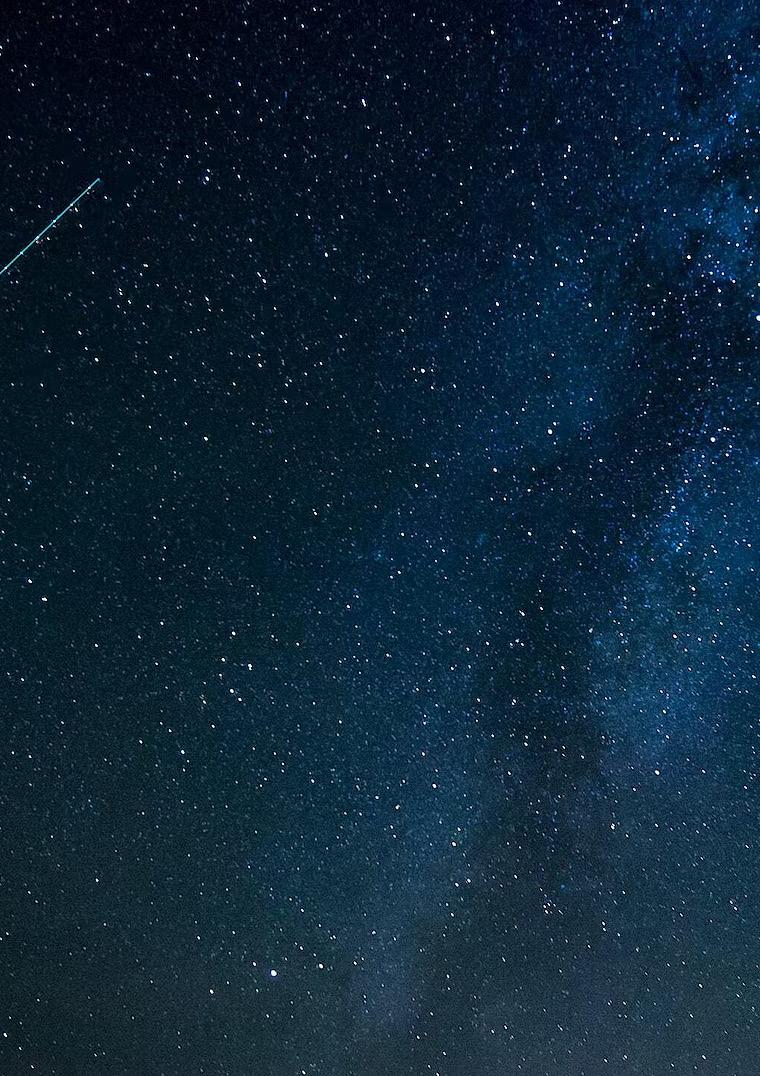
THE ANNUAL
Onceagain, The Official Doctor Who Annual range publishes another annual edition. Yes, it's in September. Does this make any sense? Nope... but that's when it's out, just like all the others before it. The Annual is mainly aimed as a stocking filler for children at Christmas and is largely bosught in December. Only collectors tend to buy it from its September release date.
This particular edition is special because it's the 60th Anniversary Edition and features all the Doctors on the front cover. Inside it contains a whole bunch of features about the history of the show but primarily focuses on the Sixteenth Doctor era and especially, The Daleks' Master Plan. No information about The Restoration is included.

MERCHANDISE RELEASED IN THE WIDWWA UNIVERSE DURING SEPTEMBER
BBC AUDIO
PAGE 10
8 SEP

NEW TARGETS
Three Target Novelisations have been released together by BBC Books, each filling out the first three stories of Season 55, broadcast in 2021. The first is Rebirth by Jenny T. Colgan, originally penned by Adrian Hodges; the second The Highland Beast by Sarah Dollard, who also wrote the original, and the third The Diaries of Time by Una McCormack, which was originally penned by Chris Chibnall and Adrian Hodges.

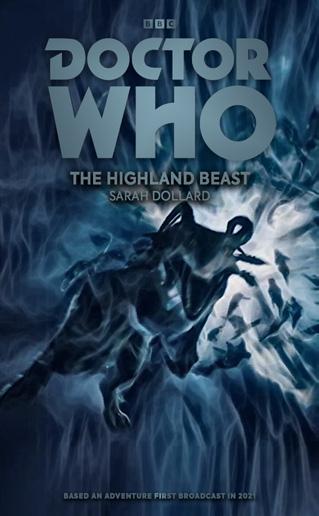
These novelisations are the second in a wave of novelisations that are being released together in bundles by BBC Books. The first were the two Paterson Joseph movies in July and the final being the last three stories in Season 55.
A press launch for these books was held in London, a week before publication, with all the writers and several members of the Doctor Who cast and crew attending.
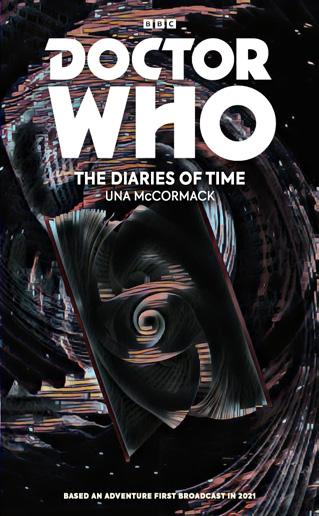
TOYMAKER VINYL SOUNDTRACK
30 SEP
Presented across 2 x 140g ‘King & Queen’ red & blue coloured vinyl discs, this 1966 TV adventure is narrated by Peter Purves, who also plays Steven. It stars Michael Gough as the Toymaker, with Jackie Lane as Dodo and a supporting cast including Carmen Silvera, Campbell Singer and Peter Stephens. Incidental music is composed by Dudley Simpson, and the familiar strains of the Doctor Who theme are courtesy of the BBC Radiophonic Workshop. The LPs are presented in a fully illustrated gatefold sleeve showing cast and credits, and inner bags featuring complete episode billings.
30 SEP
The complete three-disc (45-track) album of Doctor Who: Season 55's Original Television Soundtrack, composed by Ruth Barrett, has been released. The album has been released on CD, Collectors' Vinyl and on Digital Platforms. It covers all 8 episodes of Season 55 from Rebirth, Part One to Journey into the Unknown, Part Two.

Like previous releases, the physical editions include a booklet breaking down the writing of the score, penned by composer, Ruth Barrett.
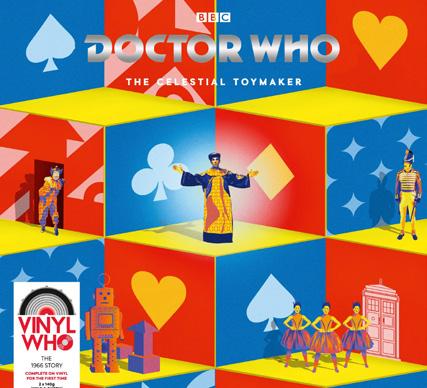
PAGE 11
ADVENTURES GO FOURTH
This adventure sees a culmination of the Dalek arc and the Revoc arc as the Doctor, Erin and Kyle encounter them both again, this time together and on Earth.


The episode is actually very simple and sees the Daleks and the Revoc attacking Earth in 1978 and using the combined forces of Erin, Kyle, Danielle, Roger and UNIT, they fight the Daleks and the Revoc and are (nearly) successful in chasing them away from the Earth.
However, at the very last minute, the Master (played by Murray Melvin) appears and tells the Daleks that here's there to help and soon the Doctor will perish. The
Doctor makes a small joke about the Master's latest disco-based scheme but the Master isn't in the mood for jokes and shrinks the Doctor with his Tissue Compression Eliminator.
THE ABoMINATIoN

THE DOCTOR

SAMANTHA BOND

ERIN STEVENSON
MONTSERRAT LOMBARD
KYLE HARRISON
WILLIAM MOSELEY
THE MASTER
MURRAY MELVIN
JO JONES
KATY MANNING BENTON
The rest of the episode sees everyone continuing to fight the Daleks and the Revoc while the tiny-little Doctor finds her way onto the Dalek ship, undectected and discovers that the Daleks hold a superweapon called the Abomination that could wipe out all life in the universe, and it's set to distruct in one-minute. Thinking fast, the Doctor uses her entire body to defuse it in time and then recodes it to centre itself on just the Dalek ship. She activates the Abomination before slipping out of the ship, through an waste port, as the ship implodes. Erin then manages to catch the Doctor, unbelievably, in her hands and
takes her into the TARDIS where she's restored to normal size.

The episode ends with everyone celebrating the victory and saying that Earth is safe forever.
WIDWWA
JOHN LEVENE DANIELLE
SUSANNAH HARKER ROGER TREVOR COOPER WARREN BROWN TREVOR COOPER
VOICE OF THE DALEKS NICHOLAS BRIGGS
VOICE OF THE REVOC NICHOLAS BRIGGS
WRITTEN BY PHIL FORD DIRECTED BY DAVID O'MAHONY
5 September 2022 at 17:00 on CBBC PAGE 12
The Daleks and the Revoc return to Earth to have their ultimate vengeance on humanity, but the Doctor has help from her friends!
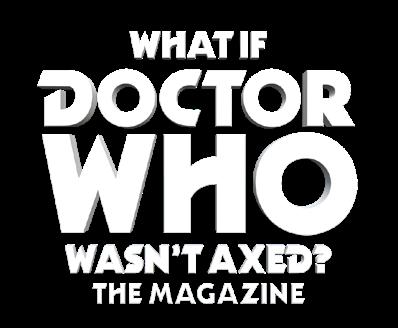
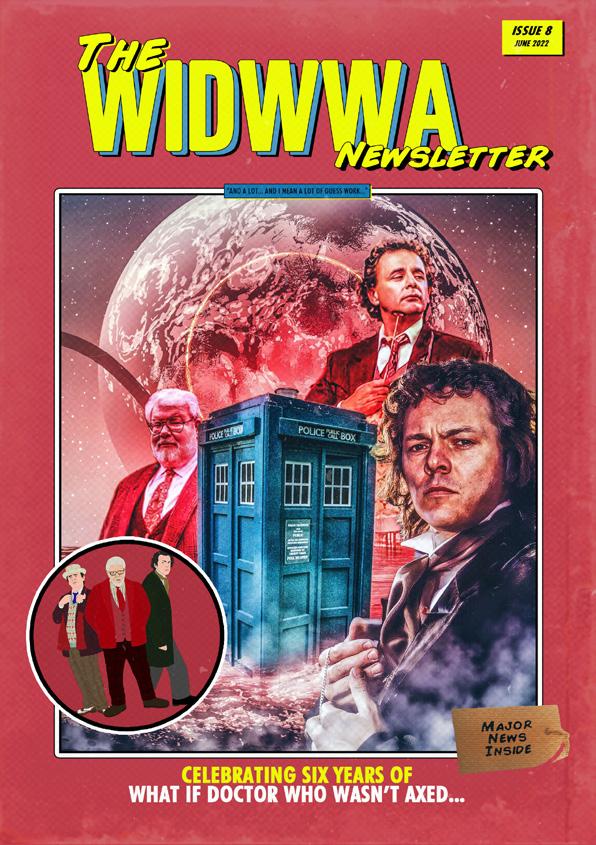

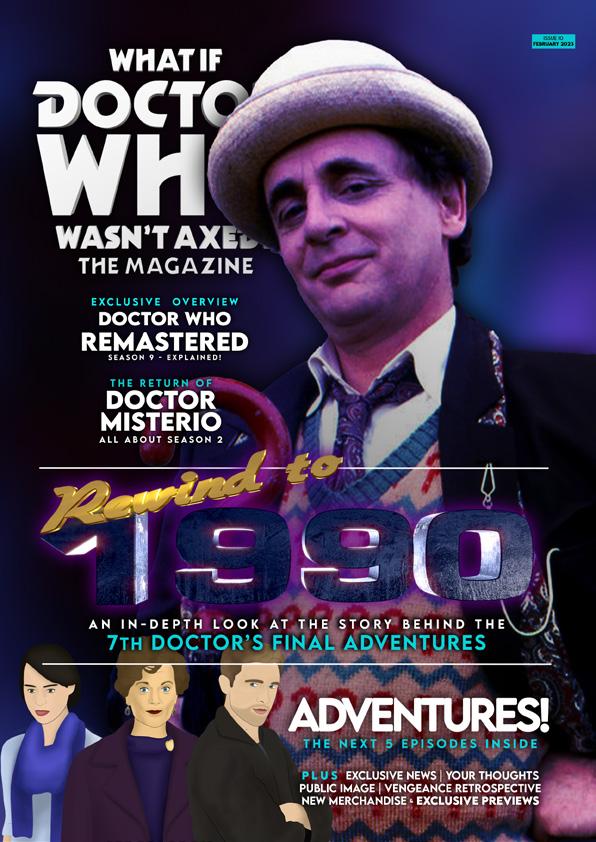

reAD everY IssUe of THE WIDWWA MAGAZINE AnD THE WIDWWA NEWSLETTER on IssUU AvAlIABle to orDer in print AT WiDWWA.co.uk WHAT If DocToR WHo WASN'T AXED? the MAgAZIne - the poDCAst All episoDes AvAliABle to listen to on the DDWf youTuBE cHANNEL As well As wherever you get youR poDcASTS
THE THIRD SEASON OF DoCtor who: throUgh tIMe AnD spACe BEGINS HERE! LEARN ALL ABOUT THE FIRST FOUR EPISODES OF THE SEASON EXCLUSIVELY!
The third season of Doctor Who: Through Time and Space had been in TVN’s plans at least since Tomasz Szafrański was hired as showrunner, if not longer, however the actual, early works on it began in November 2021, when Szafrański got his well-deserved break after finishing work on Receptura and Eve. Despite not facing logistical difficulties similar to those from Season 2, it ended up being involved with even more drama, both external and behind the scenes.

The first of it was "Lex TVN”, the media bill passed by Polish legislative, Sejm, in December 2021. The bill forbade any business entity not based in European Economic Area from owning majority share in any Polish media outlet, which according to its proponents was a mean to prevent capital from Russia or other undemocratic regimes to influence Polish public opinion. However, in practice the only business affected would be TVN, owned by American Discovery and well-known to be in heavy ideological opposition to incumbent Polish government. Under the new law, Discovery would have to sell TVN, and opposition suspected that government affiliate or company financed from state budget may buy it out. This in turn could have influenced the shape of Season 3 or even prevent it from happening, which briefly brought the subject to attention of foreign Through
Time And Space fanbase. After almost a month of high tension and vocal protest from American business and administration, the bill has been vetoed by President Andrzej Duda in early January 2022, leaving TVN as property of Discovery. This whole controversy ended up having no impact on the actual show, unlike its Christmas Special, Eve, which was aired on 25th December 2022, on both TVN and BBC Two. The reception of Eve in Poland was overwhelmingly positive, even earning the show some new fans; however abroad, the episode attracted only mediocre attention, gathering disappointing viewing figures and mixed reviews. Because of that, Maggy Chan decided to permanently discontinue bilingual format of the show. This upset both the fans and the crew working on it, but they understood that this is a logical business move and not a showcase of ill intent or a commentary on quality of the show, so everyone moved on. Everyone, that is, except for TVN.
Most of TVN Discovery Group executives in charge of programming were Poles, working for this broadcaster since its inception in 1997. TVN’s aim was always living up to the standards of Western media, including BBC, and so they saw the rejection of their content by foreign market as personal failure. Having come across opinions criticizing Eve for too much emphasis on
Polish culture and references completely alien to foreign viewer, they took them to heart. And so, around January 2022, while scripts for Season 3 were still in development, Tomasz Szafrański and production team at ATM Group received letters from TVN Discovery group’s programming department, discussing creative accomplishments of Eve and featuring numerous "recommendations” regarding development of Season 3:
- TVN argued that on-thenose references to properties like Mr Blot and Matołek The Billy-Goat ended up as mostly pointless addition that only confused non-Polish audience and harmed the episode’s performance. While not opposed to featuring pop-culture references, which proved beneficial to many works in the sci-fi genre, they suggested that these should come from either TVNowned properties, to strenghten the brand, or the internationally recognized works, so they’re familiar to both Polish and foreign audience. The "most welcome” would be references to Warner Bros. content due to its ongoing merger with
PAGE 14
"TVN [...] saw The rejecTioN of Their coNTeNT by foreigN markeT as persoNal failure"
Discovery.
- the more subtle references, like plot patterns from the play Wesele, were deemed "unhelpful and potentially harmful for storytelling”. Once again, the programming department was of the mind that it would help the show to draw more inspiration from global mainstream, which previous seasons completely neglected in favour of promotion of Polish culture – this was quite likely detrimental to its popularity not just abroad, but also among more cosmopolitan younger audience. TVN pointed out that, as an adaptation of Doctor Who, Through Time And Space should have this show as its primary inspiration, and praised the clever usage of Zygons in Eve, encouraging the creators to lean on the show’s rich legacy whenever it benefits their stories
- the heavy exposition of Roman Catholic symbols and imagery in Eve was severely criticized; according to the execs, TVN’s audience "supports separation of Church from public life” and "celebrates Christmas as secular event”.
- TVN singled out the tackling of Generation Z’s mental health issues and feelings of abandonment as Eve’s biggest strength. They noted that TVN’s mission is "highlighting serious social problems and helping people that are excluded or in need” and praised how Szafrański was able to implement these aims in his writing. They asserted that this is a great direction for Through Time And Space that should be continued, and encouraged the creators to speak up about values such as "self-esteem, pride, tolerance, acceptance, empathy, body positivity and freedom of choice”.
- it was recommended that some, and preferably most of future historical episodes should tackle events from world history. TVN claimed that by covering only Polish history, the show presents Poland abroad as "self-obsessed” and "unwelcoming to other cultures”, as well as
narrows the horizons of Polish audience.
- at the end, TVN reaffirmed that all those points are "only tips” and that "TVN values, protects and supports creative freedom of the talents it works with”, as well as "sees as its duty to ensure the high quality of the content it broadcasts and produces” and to that end "assists and supports creatives in their endeavours”.
While Szafrański and ATM Group were less than thrilled with TVN essentially handing them list of criteria to meet, they decided that they can work with that. In February, Szafrański pitched to TVN the scripts for 13 episodes long season. While it was positively received, the execs felt that it lacks something that would really appeal to foreign audience and so, they decided to add one more, and commission what was originally meant to be season finale as another Christmas special. They proposed several ideas for an extra episode, out of which Szafrański picked the most workable one.
In addition to that, another problem turned out to the companion. Paulina Walendziak still had one more season on her contract, and with Eve basically having wrapped up Pola’s arc, Szafrański wanted to make this her final season and introduce a new companion, played by his frequent collaborator Kamila Bujalska. However, he was alone in this intent; Walendziak didn’t want to leave the show until she lands another prestigious role, and the castings did not go her way. TVN also wanted her to stay on board for as long as possible, since Pola was now the only member of original main cast left and they weren’t sure how the audience would react to her exit. Both parties asked Szafrański not to give conclusive ending to Pola’s story in Season 3. This complicated his plans, but on his request Bujalska was signed anyway. The writers’ room attempted to rewrite the Season 3 scripts in order to include both companions – and failed. Even though Walendziak and Bujalska actually had gotten along quite well, no version of their characters’ long-term dynamic satisfied the creatives. Ultimately, Szafrański decided to split the stories between them.
TVN
kept Through Time
And Space on its Sunday spot, premiering the first episode on 4th September 2022, but now at 9:30 pm, meaning that each episode aired 90 minutes earlier in the United Kingdom on BBC Four. This meant, that for the first time, a foreign adaptation was exclusively premiering outside of it's original country and technically made the show original to BBC Four and not TVN...
WIDWWA
PAGE 15
"TVN claimed ThaT by coVeriNg oNly polish hisTory, The show preseNTs polaNd abroad as selfObsesseD”
The episode starts with the view of Warsaw on the sunny day, slowly moving towards The Palace of Culture and Science. Pola voiceovers that for once, the future has started looking quite promising; she began to get along with her family better, their climate campaign has gotten traction and, of course, she still traveled with Doktor from time to time. Ever since she changed face, it’s really hard for her to stay in place for five seconds, but at the same time she gained this new enthusiasm, joy and humour. It seems like she got something off her chest; Pola’s happy for her. So, yeah, after the Christmas Eve Pola’s life, aside from occasional trip to the other galaxy, has become pretty normal. It felt good.
Then the dinosaurs showed up, adds Pola, as T-Rex’s head appears before the palace and growls and we cut to the opening titles.
Unsurprisingly, this story adapts Invasion of the Dino saurs, but altered quite a bit to make for a bombastic season opener. The story opens in medias res with tyrannosaurus terrorizing Aleje Jerozolimskie and disrupting the happening organized by Pola and Krystian. They take shelter and call the Doktor, who arrives around seven minutes in, saving them from medieval bandit. JEDNOSTKA lead by colonel Lubicz-Sługocki arrives right after; from there, the plot follows the simplified baseline of parts 2, 3 and 6 of original story. The gang soon finds out that dinosaur appearances are caused by time distortions… similar in nature to these done by Zygon equipment in Eve, mortifying Pola and Krystian. The culprits however turn out to be a group of scientists, elite members and ecological activists, lead by Pola’s superior at Youngsters For Earth and lieutenant Kwiatkowski of JEDNOSTKA. With the equipment they took hold, they try to restore Earth’s climate to the prehistoric age, not quite aware how dangerous is that

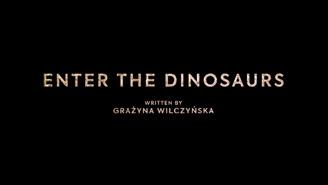
technology. The heroes eventually find their headquarters and stop them at the last minute. Only then it gets revealed where they got the Zygon tech – one of the evil scientists, Dr Bielawski, starts congratulating the Doktor and removes the prosthetics from his face, revealing the actor Artur Barciś, who introduces himself as Doktor’s greatest enemy – but you can call him the Mistrz. He was behind the Sea Devil attack in From The Sea, he sponsored the Zygon scheme in Eve and he provided the machine that caused all the trouble during this episode –but that last one was purely a stunt, he knew it fails, he just wanted to see Doktor face to face. He tells Doktor that once his real strike comes, she won’t see it coming and he’ll have his revenge, before teleporting away.


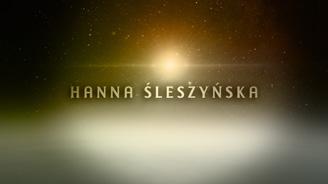
 WIDWWA
WIDWWA

PAGE 16
Thisepisode serves a sequel to previous season’s The Last Wonder, bringing us a 100 years further into the future to Aarchnaughts homeworld, Rosadyne. The oppressors have now become the oppressed, as humanity chased after Aarchnaughts’ retreating fleet, conquered their planet and



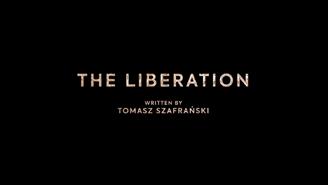
ion – Emma (yes, Emma) Legato. She’s the leader of Aarchnaughts resistance and daughter of the planet’s vice-governor, who abandoned the life of luxury ten years
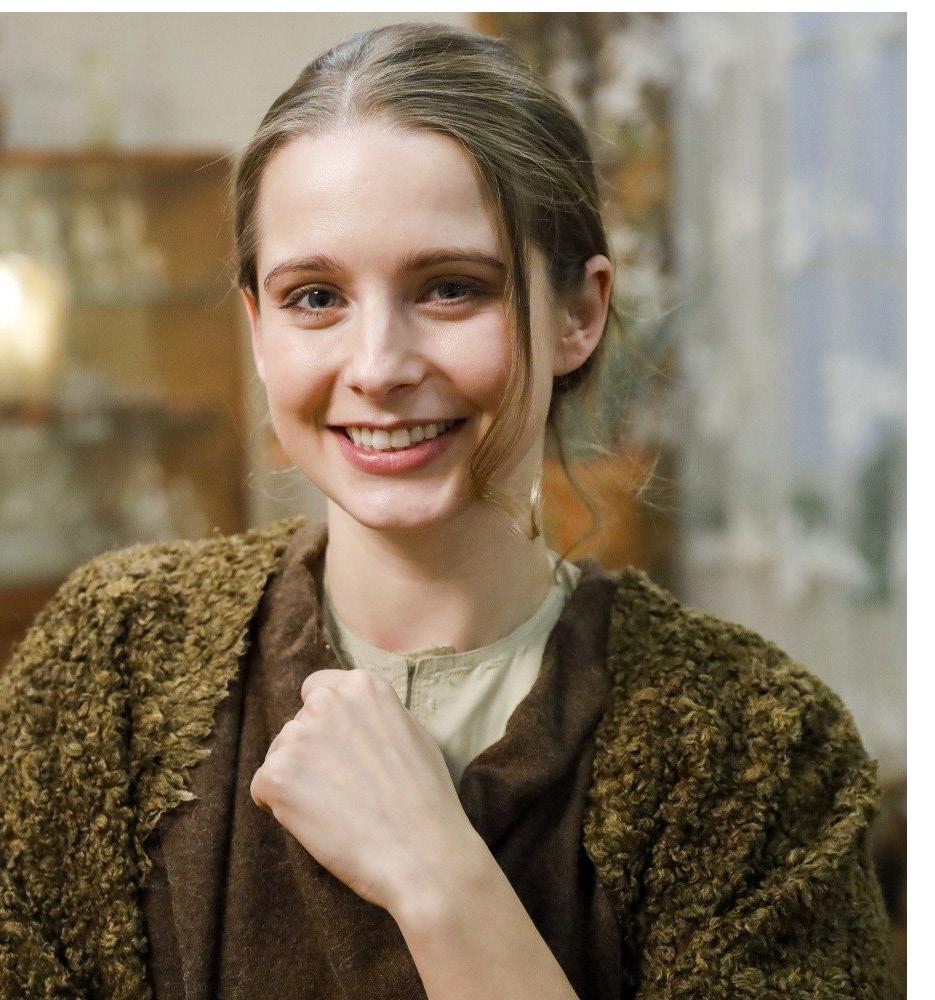
Emma seems to be its embodiment. Emma in turn takes her salty remarks (“saving the world is easy” among others) as the bagatelisation of Aarchnaughts suffering and lack of care; then it gets even worse when she learns that Pola is from the “bigoted” 21st century. They still save the day together, and with her work on Rosadyne done, Emma now wants to go with the Doktor and learn from her how to defeat oppressive regimes on universal scale. The Doktor’s inclined to agree, but Pola heavily objects, claiming that she doesn’t deserve it and as long as Pola’s in the TARDIS, she won’t let her aboard. The Doktor yields and departs, bringing Pola back home… and then comes back to Rosadyne. After all, Pola’s not on board right now!
 WIDWWA
WIDWWA

PAGE 17
This first purely original story of the season takes us to Zakopane, where Pola’s family came for a trip. While visiting Kornel Makuszyński Museum, Pola and Krystian unexpectedly find the Doktor’s portrait, which they soon discover hides the short story penned by Kornel. From here the story splits into two plots: the A-plot follows the Doktor, who comes to visit the aforementioned writer in hopes of

the help of equipment bigger on the inside and the geological properties of Tatry mountains, but the thieves spot them and extract from time, trapping them in the 1950s’ Zakopane. In the B-plot, Pola and Krystian learn all this from Kornel’s


thwarting the evil plan. The episode is filled with references to Kornel Makuszyński’s books and other works, however they’re not necessary to understand the story. In the end, Doktor’s investigation doesn’t prove very fruitful, as Kornel assures her that Matołek the Billy-Goat is a fictional character and whoever she met, that couldn’t have been him.
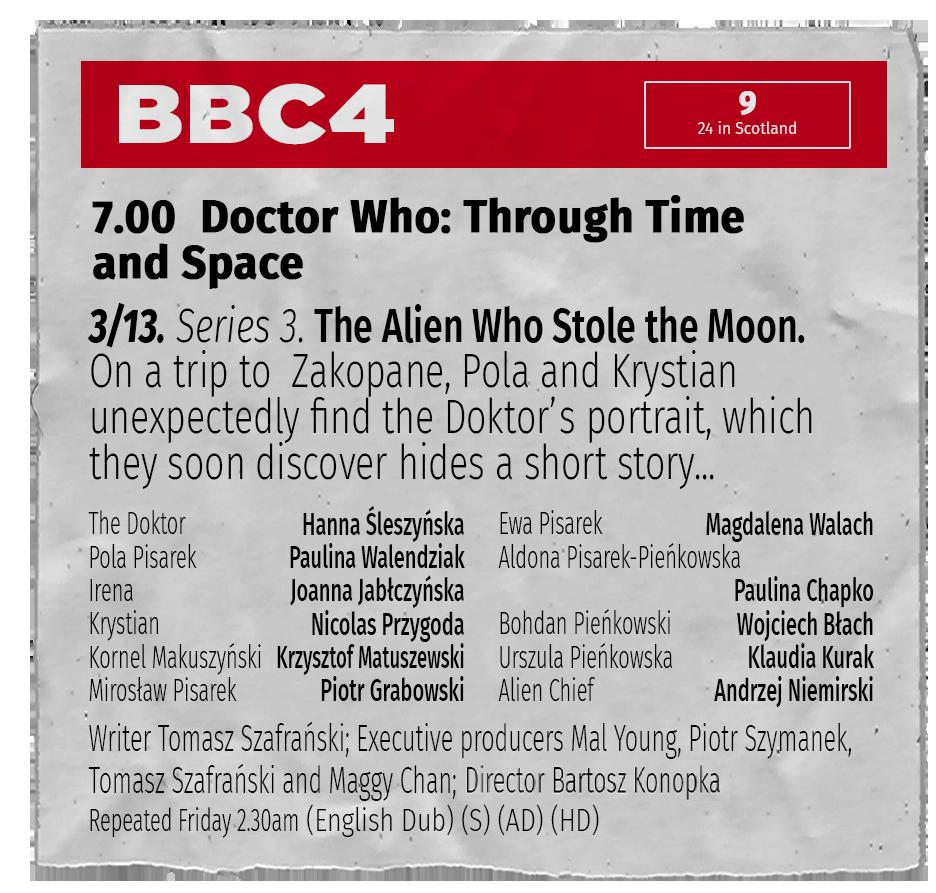



PAGE 18
This episode was dedicated to memory of legendary Polish actor Franciszek Pieczka, who played Kan’po Rinpocze in All Praise To The Great One. He sadly passed away two days before the broadcast of Beyond The Dead Planet.


Originally Szafrański wanted to adapt The Daleks’ Master Plan as a twopart story, concluding both the Daleks and Mnich trilogies, but dropped the idea when the news came out about Ronald D. Moore retelling the story in the main show, which would obviously make cut-down Polish version look ridiculous in comparison. And so, two other stories were commissioned, the first one being this adaptation of Death To The Daleks, which was chosen due to being the least difficult to adapt.
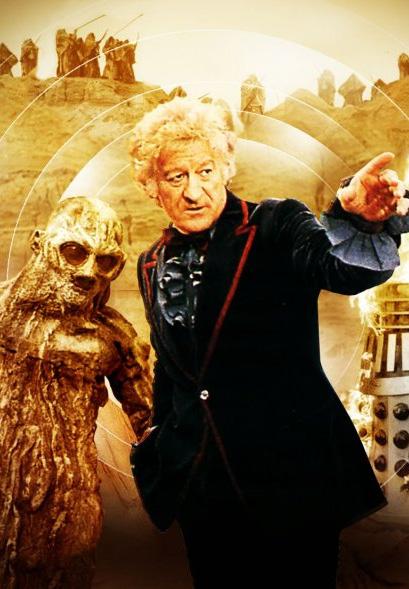
The story still received quite a makeover to fit for its new role as the first proper adventure of Emma in the TARDIS (as you probably figured from her
absence, last episode took place after The Liberation from Pola’s perspective, but before Enter The Dinosaurs from the Doktor’s). Her role is even more proactive and involves far less shrieking than Sarah Jane’s.
Primarily the content of last two parts is used, with the events of first two being cut down to first 10 minutes, and the human expedition being replaced by just a single agent. He and Emma spend the latter part of the story sabotaging the Dalek excavation, while Doktor faces the riddles of the living city - this last section has been slightly expanded. The humorist side of the story is embraced and most goofs from the original are turned into full-on gags, giving Hanna

Śleszyńska a chance to do what she does best and coin comedy gold out of them. For example, the TARDIS model that the Daleks later use for target practice accidentally comes from Doktor’s pocket and the mutants confiscate it. Good thing that she has more of these!

That's it for now, but next time, we'll head into October as Doctor Who: Through Time and SpaceSeason 3 continues in the next issue, with Episodes 5-9...

WIDWWA

PAGE 19
IN CONVERSATION WITH MATT MoIR
biggest creative forces in the history of What if Doctor Who Wasn’t Axed?, creator, Benjamin Windibank and former co-writer, Matt Moir, are meeting in person.

The reason is because the British Film Institute (BFI) are screening the Season 2 story, The Time Meddler, to fans in promotion of Doctor Who: The Collection - Season 2 and both Windibank and Moir decided to go along. Following the
hotel room where they spent 90 minutes speaking about Moir’s history on What if Doctor Who Wasn’t Axed?. What follows is a transcript of the first half of the interview.
BEN: So, Matt, you joined the What if Doctor Who Wasn’t Axed? Series in 2017, to your best memory, how did that come about?
MATT: Brute force… Umm, basically, I just kept messaging you, like all the WIDWWA fans,
MATT: I was the one that succeeded, yeah. Basically, it was the case of that I gave off a friendly vibe. I don’t know, I gave off a vibe of someone who wasn’t weird, just really into it.
BEN: So, then, how did you “find” the series to begin with?
MATT: YouTube.
BEN: Well yes, but elaborate?
MATT: Well I started the series from the beginning, with Season 27, but the video I think
PAGE 20
the fIrst pArt of An In-Depth IntervIew wIth forMer Co-wrIter MAtt MoIr
I did first see was Season 38 or Season 39.
BEN: So the first thing I remember is obviously seeing you in the comment section a lot, but then I got a Twitter DM from you with some fan art which I must say was absolutely terrible.
MATT: I have gotten better at image manipulation, I’m not any Soundsmyth Productions…
BEN: Friend of the series, Caroline, by the way.
MATT: Who now works for Big Finish, which is the coolest thing ever.
BEN: We were one of her testing grounds, I guess, before she made it big time!
MATT: Well her influence was more well known on the musical side to begin with, then she started doing art, right?
BEN: So Caroline did the Season 49 theme and she did the Panopticon Series 4 and Series 5 theme, but then she did a bunch of posters: Genesis, Until the World Ends, Panopticon Series 4, Season 49, 53 & 54, The New Renegade Season 1 and finally The Upgrade from Tomorrow. She had just begun her first gig on Big Finish when she delivered The Upgrade from Tomorrow’s poster and the tone was very much like “I’ll give you this but this has to be the last one, I’m sorry”, which I was happy with because she deserved the big break, if not a little gutted that we’d lost such a talent on the series.
MATT: Yeah she went onto bigger things and you know what, sometimes that’s just life.
BEN: But anyway, your fan art was far from that…
MATT: Yes, it was…
BEN: At the time, I was sort of “thanks but no thanks” and I gave a polite reply but it sort of continued from there.
MATT: I think I kind of realised at the time that they weren’t the best but I didn’t know what I could have done differently but now I do know a lot better so… I think after that, we just ended up talking as fans of Doctor Who, as a whole, unrelated to what had opened the original conversation. During that time, I think you ended up showing me the Rebel Zero title sequence, when it was a work in progress, just to get an opinion.
BEN: I was trying to make the title sequence work and it just wasn’t working. So I thought, right I’ll just ask Matt for advice because he’s someone who exists and knows about WIDWWA and is worth asking for advice. So I did and that’s when you first became creatively involved. It was a complete accident, almost.
MATT: I think I just said something like “brighten up the text” and that worked.
BEN: That did work, yeah. What’s interesting is somehow, in a turn of events that I really don’t remember, you went from consulting on Rebel Zero’s title sequence to fully co-writing Season 43 and it happened very fast.
MATT: I think I did give some ideas for Rebel Zero, as well, such as lore around the Vardans but it wasn’t anywhere near co-writing.
BEN: I think it was because
Season 43 was “we’ve got Paul Cornell, what would he do with Doctor Who” and you made it very clear to me that you knew Paul Cornell’s Doctor Who very well, both on-screen and in expanded media. I remember writing Season 43 well because we were on a 4-hour call on Skype and I was on holiday in Iceland…
MATT: I don’t remember you being in Iceland, but maybe you just didn’t mention it.
BEN: Trust me, I mentioned it a lot.
MATT: I clearly didn’t pick up on that or I just forgot, it has been a while.
BEN: So I was alone in a flat in Iceland for 4-hours and, over Skype, I explained to you the overall story I had for Season 43 and then we “broke” it, episode by episode, together. That was the first time I’d ever done it like that, completely in the style used in professional writing rooms, and it was a really encouraging creative process, I think.
MATT: It was often the case that you had an idea in mind and I’d say “wouldn’t it make more sense to do this” and then you’d develop that further. I mean, I’m mainly talking about Ace’s involvement in the season because I’m a big Ace fan and I always have been and we kind of broke the season down into each individual episode, apart from the bookends, focusing around a separate character. I thought that would really suit the Paul Cornell style and his vibe, and thought he’d do that with Ace.
BEN: So that certainly showed me that this was something I wanted to continue and
"WHEN YOU FiRST BECAmE CREATiVELY iNVOLVED... IT WAS A COmpLETE ACCiDENT, ALmOST."
PAGE 21
"I kNOW I WAS HEAViLY iNVOLVED iN THE CASTiNG OF pATERSON JOSEpH…"
it was Revelation next but I’m not sure how much involvement you had with that one, I think I handled a lot of that on my own.
MATT: No, I can’t remember doing much on Revelation at all. I know I was heavily involved in the casting of Paterson Joseph…
BEN: I think that was the first major creative choice that you really made on the series. You were heavily involved in the casting of four Doctors: Paterson Joseph, David Suchet, Samantha Bond and Adjoa Andoh. Paterson Joseph was the only one where you initially originated the idea but all the rest you had a big involvement in.
MATT: Paterson Joseph was moreso a thing of that he was nearly cast as the Eleventh Doctor in our world and I wondered if Paul Cornell and Gary Russell were making that decision, instead of Steven Moffat, obviously a few years earlier, that maybe it wouldn’t gone the other way and he would’ve been cast. I thought he would
BEN: Now, Michael French, I must add, because I’ve become wiser with age…
MATT: Richard E. Grant because he just was a key-choice of the era, he’d been flirted with in real life in Curse of Fatal Death and Shalka…
BEN: It was more like, for me: here are the creatives we’ve got, here are the pool of actors we’ve got, here are the actors who have shown and expressed interest in Doctor Who, who makes sense for that? For example with David Suchet, we needed an older established actor who was only ever going to do it for two years and a movie. We needed someone who had a bit of star power and was doing it on a short contract as, sort of, a big ‘guest star’ Doctor who was doing it for just two series and a movie.
MATT: Which made sense for David Suchet. He fit the bill and there were a few others in contention too, who were similar…
BEN: Another David… David Warner was in contention.
MATT: Yes, he was.
BEN: Well, he was even in contention, in the very early stages for Fourteen as well.
about renewal and a new lease of life for the Doctor.
MATT: So back to Paterson
Joseph, at the time, I think he would’ve been a perfect choice really. You know, to my knowledge Paul Cornell isn’t a racist and I mean in “his” version of Doctor Who, which is Scream of the Shalka, the companion is a person of colour.
BEN: Paul Cornell, as well, has been a big outspoken supporter of diversity casting and he’s been one of the biggest cheerleaders of the Chibnall era, especially from that cohort of early Modern Who writers.
have been an interesting choice and it felt without the spirit of WIDWWA because the casting choices felt like they were going on a trajectory and a natural follow-on from a Richard E. Grant then Anthony Head casting. Think about it, you had Richard Griffiths who was the de-facto Eighth Doctor choice; Paul McGann because you were dumb…
However, the reason we decided against it, if you remember, was that the Fourteenth Doctor needed to be a renewed incarnation of the Doctor, the first of a new regeneration cycle, and although it made perfect narrative sense for it to be David Warner it didn’t fit thematically to go from an old man to an even older man, when thematically it was all
MATT: Exactly and even with the way he handled racism in Human Nature, it proved, at least in my view, that he did it well and understood what he was doing. Considering Paterson Joseph is “diversity casting”, which by the way, wasn’t even a thing for us. We had plenty of other options for the Doctor and Paterson Joseph just won out. The other stipulation we really had was “British”. You were, if I remember correctly, considering going down the old woman route with Imelda Staunton.
BEN: Well yes, she was considered a number of times.
MATT: And of course you won out with an old woman companion, in the form of Angela, and you had this barmy idea later on of Judi Dench as a cave woman companion. As soon as you mentioned the
IN CONVERSATION
WITH MATT MoIR
"RiCHARD GRiFFiTHS WHO WAS THE DEFACTO EiGHTH DOCTOR CHOiCE; pAUL mCGANN BECAUSE YOU WERE DUmB…"
PAGE 22
"pAUL CORNELL, AS WELL, HAS BEEN A BiG OUTSpOkEN SUppORTER OF DiVERSiTY CASTiNG..."
Judi Dench idea, I basically just tried to veto it and I succeeded.
BEN: Well, there just wasn’t any way she was going to do a “TV show” let's be honest. I think it was the actual case that cave woman Judi Dench was the original idea for Season 44, and we then settled on cave woman Jacqueline Pearce before that character, over a lot of development, evolved into Angela.
MATT: I thought it was later.
BEN: No, I think it was Season 44.
MATT: Anyway, Imelda Staunton. We just couldn’t quite get it to fit, I think.
BEN: No, as far as I remember, the reason that we didn’t go for Imelda Staunton, at least for the Twelfth Doctor, was simply because… Paterson Joseph was a better idea. That was it.
MATT: Okay.
BEN: Because as soon you suggested Paterson Joseph, I went “That’s a better idea”. I tried to have Imelda Staunton again for 13, and she fit the bill completely, but then I was like “I like David Suchet better”. Imelda Staunton then came
but I still think Samantha Bond would have been far more likely to have won out anyway.
MATT: I mean Imelda Staunton would’ve been a good choice, don’t get me wrong. I mean she was well known in 2007, she was well known in 2017 but now in 2022, she’s very very well known. I mean she is the Queen. Now, back to Revelation, I brought up the idea that the Master, who was Geoffrey Bayldon…
BEN: Oh yes. I was writing the script and I went to you and said “Matt, there’s one big problem I’ve got with Doctor Who: Revelation. I don’t have a revelation. I can’t think of a revelation to stick in Doctor Who: Revelation…”
MATT: So I came up with that and we canonised Trevor Martin as the Master. I mean my mindset with WIDWWA, at the time, was a lot more “what would be a cool story to do”…
BEN: And mine was a lot more “what would they actually do”…
MATT: So we contrasted each other quite well and it worked as a partnership.
able to say things like “let’s do this Big Finish adaptation” or “let’s do The Empty Child”…
BEN: Well yes, and I had to work out a way of explaining that as “Moffat’s last hurrah” to make the story make even a slither of behind-the-scenes sense.
MATT: Well I always wanted to do Human Nature but you forbid it because you’d done Leftover Series 3 based upon it. Which was annoying because we had Paul Cornell right here and we had 2007 right here.
BEN: Yeah we had a few on our bucket list that we just couldn’t make work logistically.
MATT: I realised that with Seasons of Fear. I always thought that be a great story for a Doctor Who movie, but there
around for 14, but by that point, because we’d mentioned the fact she’d been in contention before, her casting as the Doctor had become a bit of a meme in the WIDWWA fandom so I ruled her out fairly quickly. Maybe if we hadn’t disclosed her identity to the fandom, she’d had got the role,
BEN: Yes, you were “what’s a good story” and mine was “what makes sense” and we complimented each other in that way.
MATT: But as the series drifted more and more into it needing to be its own thing, give or take a few ideas, I felt there was less and less I could contribute. Back in the era of Season 44, for example, I was
was no real opportunity for that because of how WIDWWA was structured. Oh, jumping back a bit, Lizzie was originally going to be actually called Alison… her original name from Scream of the Shalka
BEN: Well yes, I had to fight hard to get it changed. You really didn’t like changing it but I just said again and again that we couldn’t have two current companions called Angela and Alison… the names were just too similar. So, after much arguing, we decided on Lizzie.
MATT: So I came up with doing Scream of the Shalka and I wanted that as the opener and I wanted to have Lizzie for Season 44 and introduce Angela at the end… and you wanted the opposite.
BEN:And obviously I won
"BECAUSE AS SOON YOU SUGGESTED pATERSON JOSEpH, I WENT ThaT’s a beTTer idea"
"WE CONTRASTED EACH OTHER qUiTE WELL AND iT WORkED AS A pARTNERSHip."
PAGE 23
"I FELT THERE WAS LESS AND LESS I COULD CONTRiBUTE..."
that argument.
MATT: Having a new monster as the finale would have been a lot more daring for the show, than the opener, which is why I wanted it to open the season.
BEN: WIDWWA is just more daring than the same formulaic New Who finale structure, I guess.
MATT: So in Season 45, we did do Seasons of Fear but as a whole “Season of Fear” and it was my idea to go for Paul Darrow as the husband. You’d introduced me to Blake’s 7 a few months earlier, so I’d recently become a full-on Blake’s 7 fan and I think you could just about make them casting Jacqueline Pearce and Paul Darrow as husband and wife make sense and just be like a nod to sci-fi fans. We know that Gary Russell and Paul Cornell were fans of Blake’s 7, so it wasn’t hard for me to persuade you to do it.
BEN: And then we had the ultimate Blake’s 7 reunion episode in Storm Warning, where we had Gareth Thomas, Jacqueline Pearce and Paul Darrow in one episode.
MATT: Well that was because Gareth Thomas was in the original Big Finish version, so the stars just sort of aligned.
BEN: And we only did Storm Warning because it worked with the story of the season and of course… Gary Russell.
MATT: True. It was also my idea to stick Scott Bakula into Operation: Salvation…
BEN: So then we did a Christmas Special.
MATT: Yes because we were insane. It was like, to
be fair, that we had neglected Christmas Specials up until that point.
BEN: If you look at 2008 and the BBC One Christmas roster, everything was getting a Christmas Special. 2008 was when BBC One went “you get a Christmas Special”, “you get a Christmas Special”, “you get a Christmas Special” etc… Doctor Who wasn’t having them beforehand because they just hadn’t been a thing and they hadn’t established any sort of tradition with them. But in 2008, it just made sense that Doctor Who would get one. It didn’t become an annual thing though, it was moreso that Doctor Who got a Christmas Special when it made sense for Doctor Who to have one.
why we weren’t on a 13x45 minute episode format and the odd 2-parter… So the Christmas Special that we did do was The One Doctor
MATT: Well Doctor Who was a different format… and didn’t always fit the usual Christmas Special cycle.
BEN: The thing I always felt was important with WIDWWA was that from 2005 onward, it shouldn’t just become New Who.
MATT: Well yes, New Who’s format and tone was entirely because it was a new show launching.
BEN: Doctor Who in the WIDWWA universe had an extra 15 years on New Who, so it was a slow development overtime, which got to similar points, but fundamentally wasn’t getting to the same place in 2005 that New Who was starting from, and that was very important. So that’s why things like Christmas Specials didn’t just start in 2005 and that’s
MATT: Another Big Finish adaptation. I suggested this one I think. It made the most sense. It was Big Finish’s Christmas Special and it was just very easy to translate. Gareth Roberts was a key member of the Doctor Who team in WIDWWA, at the time, and he wrote The One Doctor, so that made even more sense too.
BEN: I do want to point out about Gareth Roberts that went the whole controversy surrounding him kicked off, I thought it was very important that we wouldn’t remove it and we wouldn’t change it as a response, because in 2008 they didn’t know Gareth Roberts was a massive transphobe. I think it’s very important to stay realistic. Anything from the point of 2018, when everything kicked off, he isn’t involved in anything, just like real life, but before that and, yes he is, because he would’ve been.
MATT: Because if you’d just retconned him out of existence, like some people have done with these sort of people in similar series, then it just defeats the point of the exercise. It unfortunately makes sense.
BEN: We did make some
IN CONVERSATION
WITH MATT MoIR
"IF YOU LOOk AT 2008 AND THE BBC ONE CHRiSTmAS ROSTER, EVERYTHiNG WAS GETTiNG A CHRiSTmAS SpECiAL..."
PAGE 24
"NEW WHO’S FORmAT AND TONE WAS ENTiRELY BECAUSE iT WAS A NEW SHOW LAUNCHiNG..."
changes with The One Doctor though. We changed most of the cast to be a lot more sort of BBC Light Entertainment
‘Christmas Stars’ because that made sense as the sort of thing that they would do. On Big Finish, it’s just sort of whoever they could get hold of…
MATT: We put David Walliams in there. We put Richard Briers instead of Christopher Biggins because we’d already used him.
BEN: Then onto Season 46 and this is the one where I
seasons beforehand.
MATT: I think he would’ve turned it down if he was to have been offered something similar in reality, but then again, in WIDWWA, he would’ve been in a very different position overall.
BEN: Here he has done a lot of Doctor Who TV scripts, whereas in the real world that just didn’t work out; his journey with televised is very very different in our universe. WIDWWA is all about cause and effect and decisions leading to different places and I think Rob Shearman’s career would’ve been extremely different in the WIDWWA universe. Logically, from a production perspective, whether he would’ve said yes or no, he is who they would’ve asked based on the circumstances they were in.
MATT: What if Doctor Who Wasn’t Axed? started as an ideal anyway, so the ideal outcome of what would’ve followed is what this exercise is…
because we wanted to do Midnight because we realised that we’d done Russell T Davies already without his best idea and that he probably wouldn’t come back, so we found a complicated way of doing Midnight.
BEN: Well we thought he wouldn’t come back.
MATT: Well, yes, we thought that!
think our creative partnership probably worked the best out of every season. I think this is where we peaked.
MATT: The thing that I perhaps regret about Cannon Fodder, or A Blast from the Past as we originally called it, is that it probably would’ve worked best as a kinda spinoff adventure.
BEN:If we had Cold Front at that point, then it probably would’ve been a Cold Front episode.
MATT: : I think it was far more Leftover than Cold Front. I think Rob Shearman becoming Script Editor was definitely my doing when it came to Season 46.
BEN:It made sense because he was essentially the most prominent writer in the two
BEN: And stuff that I included in the series, as predictions, three or four years ago is well… happening right now in real life. The whole Paramount deal isn’t too dissimilar from the Disney deal that was announced (as of this interview taking place) just a few days ago. That wasn’t just good luck or a shot in the dark, it was because I always knew that logically the trajectory of Doctor Who would go there. It’s just WIDWWA had a much-needed head start and got there a hell of a lot earlier.
MATT: You even predicted Tegan coming back!
BEN: Although I had her still working in air travel, which wasn’t quite what they went with and that was probably for the best…
MATT: Well that was only
BEN: Though the obvious way to get things wrong is if I suddenly brought Russell back now and had him become showrunner. Then I’d be able to go “In 2022, Russell T Davies would’ve done this in Doctor Who” only to be instantly proved wrong. So yes, that would be pretty much the dumbest thing possible that I could do right now.
MATT: He could bring back Richard E Grant as the 17th Doctor!
BEN: Let’s not even go there.
MATT: So… at the end of Season 46, we killed Lizzie.
BEN: Yes.
MATT: And it was kind of just out of necessity, wasn’t it?
BEN: The idea was that we didn’t want companions to cross over into a movie that weren’t already in a previous movie. We weren’t always going to kill her but as soon as we decided to do Turn Left then the idea was pretty much one of doing Turn Left but where the companion actually dies when
"SEASON 46... THiS iS THE ONE WHERE I THiNk OUR CREATiVE pARTNERSHip pROBABLY WORkED THE BEST... I THiNk THiS iS WHERE WE pEAkED."
PAGE 25
"WIDWWA STARTED AS AN iDEAL ANYWAY, SO THE iDEAL OUTCOmE OF WHAT WOULD’VE FOLLOWED iS WHAT THiS EXERCiSE iS…"
CONVERSATION WITH MATT MoIR
they sacrifice themselves.
MATT: We hadn’t had a companion death for a while. Not since Sandra…
BEN: So Lizzie didn’t carry on and we cruelly murdered her… finishing the season and TV Twelfth Doctor.
MATT: So then we did Shada… I don’t know why it was Shada though.
BEN: Well we had a third movie to do and we just started thinking about whether anything had been done with Shada in the WIDWWA universe, and came to the conclusion that the 1992 VHS only happened because of the Wilderness Years being a thing so Shada was pretty much a hidden gem, only known to only the hardcore fans really.
MATT: It just fit for an epic movie.
BEN: And… my thought process was that if they did Shada, they could stick Douglas Adams’ name all over it… which, by the way, sells… a lot. For Paramount trying to sell a sci-fi movie, Douglas Adams’ name does a lot.
MATT: Then we came up with the idea of replacing Skagra with Gregori. Obviously
Chris as a companion and then Zenla who was a newer version of Romana really. A lot of what came out of WIDWWA for the next few years came out of the decision to do Vengeance as an adaptation of Shada.
BEN: It was the pilot of the next few years.
MATT: The beginning of the end… for me. I didn’t know it at the time though. Once we brought in Gregori, we very quickly decided on Peter Capal-
di. Juliet Landau was just out of ease because she’d been Romana on Big Finish and it made sense with Paramount and that. I think you cast Chris…
BEN: I thought Dougray Scott just a good choice for the role. Post-grad student at Cambridge University, he just fit the bill.
MATT: I came up with David Arnold and Martin Campbell… because I’m a James Bond fan, but Martin Campbell is a brilliant director when he’s reinventing so it made the most sense.
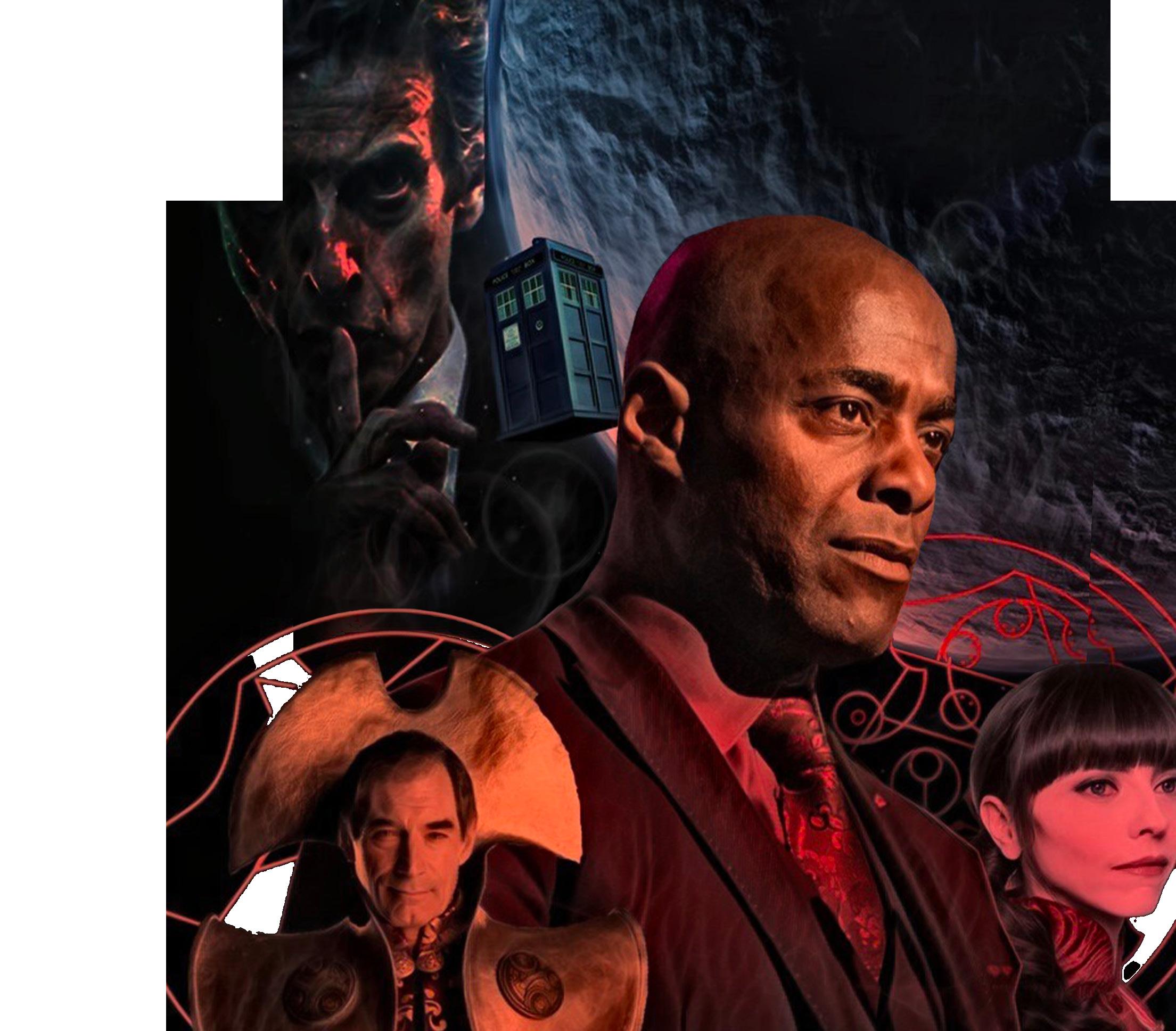
The rest of this interview will be published in the next month’s issue.
WIDWWA
IN
"FOR pARAmOUNT TRYiNG TO SELL A SCi-Fi mOViE, DOUGLAS ADAmS’ NAmE DOES A LOT."
PAGE 26
" THE BEGiNNiNG OF THE END… FOR mE. I DiDN’T kNOW iT AT THE TimE THOUGH..."





reAD everY IssUe of THE WIDWWA MAGAZINE AnD THE WIDWWA NEWSLETTER on IssUU AvAlIABle to orDer in print AT WiDWWA.co.uk WHAT If DocToR WHo WASN'T AXED? the MAgAZIne - the poDCAst All episoDes AvAliABle to listen to on the DDWf youTuBE cHANNEL As well As wherever you get youR poDcASTS
AFTER... AFTER WHO
In The WIDWWA Newsletter Issue 7, we went into detail about Doctor Who’s first aftershow, After Who, which ran for 202 episodes between 2004 and 2016. In case you didn’t read the original article, to recap, the show was a studio based aftershow broadcast, for the most part, on BBC Three. Each episode contained a number of guests, usually cast or crew involved in the making of that week’s episode, who’d discuss it - from 2011 they did so in front of a live audience. Additionally, from 2006, each episode featured multiple pre-recorded featurettes which went into depth about an aspect of production. Over the years, the series was hosted by Jo Whiley, Zoe Ball and Rufus Hound.
Largely due to the decision to axe BBC Three as a broadcast channel in 2016, but also because of declining ratings and overwhelming criticism with the current format of the show, the BBC axed After Who in 2016, with the final episode
being “After The Third Planet, Part II”. What followed were multiple different attempts to replicate After Who’s success…
for 33 episodes, covering The Elysium: Season 2, The Last Winter, Doctor Who: Season 51, The Elysium: Season 3 and The Martian Equinox. Due to criticism of the format, and a desire to return to something which allowed more interaction with the fandom, the BBC decided to cancel Doctor Who Extra in 2018 and replace it with Doctor Who: The Fan Show for Season 52.


The first came in September 2016, coinciding the premiere of The Elysium’s second season. The show was entitled Doctor Who Extra and was exclusive to BBC iPlayer in the UK and to CBS All Access in the United States, making Doctor Who Extra the franchise’s first CBS All Access Original Series. The format of Doctor Who Extra was incredibly stripped down, lasting just 1015 minutes an episode. Essentially the episodes contained all the pre-recorded featurettes that you’d find in an After Who episode, linked together by narration by Nicholas Briggs. Doctor Who Extra lasted
Doctor Who: The Fan Show essentially took the format of After Who but did it much cheaper and without any cast or crew from the actual show. Like Doctor Who Extra it was exclusive to BBC iPlayer in the UK and CBS All Access in
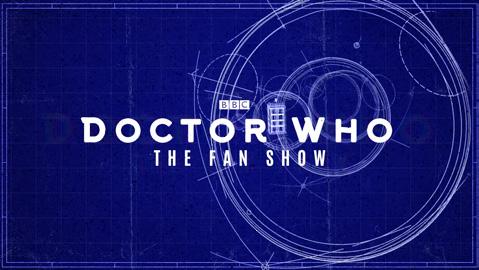
the United States. Episodes typically ran for 20-30 minutes and contained the features that you’d see in Doctor Who Extra, intercut with, the presenter, Rufus Hound interviewing a panel of five Doctor Who fans, usually from the internet, about the episode against a green screen, with the TARDIS behind them. While this format was a lot more popular than
Doctor Who Extra, the extreme cheapness in production value was heavily criticised. Rufus Hound, who had previously hosted After Who, was not a popular choice with fans either. Additionally the USP for The Fan Show was that its studio
PAGE 28
11 Septeber 2016 - 1 January 2018
33 EPISODES
Narrated by Nicholas Briggs
Typical Length: 10-15 minutes Release: BBC iPlayer/CBS All Access following the broadcast of latest episode
"The formaT of Doctor Who Extra was iNcredibly sTRippeD DOWn"
panel featured Doctor Who fans, but the choice and the selection of these fans was always controversial. They were nearly all ‘WhoTubers’ that were popular at the time and were all big fans of the current era of the show and nearly always gave positive feedback and discussion to the episodes. The series was criticised as feeling staged and like propaganda, especially coming in an era that was constantly losing its popularity. Doctor Who: The Fan Show was even more short lived than Doctor Who Extra, lasting just 24 episodes from the beginning of Season 52 to the end of The Elysium: Season 4, ending in November 2018, within the same year it began. The cancellation had been announced in September, with the BBC promising that a “brand new and exciting” aftershow would be launching in time for the New Year’s Day special.
Following this announcement, speculation went crazy in the fandom, as fans tried to each come up with the format that they felt best for a Doctor Who aftershow. Essentially, the vast majority of people just described a revival of After Who. The BBC became incredibly tight-lipped about the new aftershow and just what the format was. It wasn’t until November, during the final edition of Doctor Who: The Fan Show, that any more details came to light. Rufus

Hound mentioned toward the end that he’d be back on the 3 December, alongside Toby Hadoke & Nicholas Briggs, on the Doctor Who YouTube Channel.
It then wasn’t until 3 December 2018, with the release of the first episode of Doctor Who Weekly, that anything more about the show was known. In the first episode titled “Welcome to Doctor Who Weekly!”, the three presenters, Rufus Hound, Toby Hadoke and Nicholas Briggs explained that the series would be a weekly, all-year-round, YouTube series released on the Official Doctor Who YouTube channel. If an episode from the franchise, whether it was main universe or a foreign adaptation, was broadcast that week, then the episode would focus on that episode, however, if no Doctor Who franchise episodes were broadcast that week, then the episode would focus on something else about Doctor Who, whether it be looking back at an old episode, or tying into a merchandise release, for example.


The three presenters of the series also explained that they’d rotate presenting duties each week, so that the series could easily be made all-yearround. For example, Episode 2 was presented by Nicholas
Briggs, Episode 3 by Rufus Hound, Episode 4 by Toby Hadoke and then looping back around so that Episode 5 was presented by Nicholas Briggs, and so on. Each episode lasted 15-30 minutes, depending on how much content featured in the episode.
Due to a new TARDIS set having been built for Season 53, the old 2013-2018 set was converted into Doctor Who Weekly’s new set, removing the much-criticised “chairs in front of a green screen” aesthetic from The Fan Show. The TARDIS console had been removed and replaced by a round table and curved LED screens were plastered around the balcony walls of the set (with the book-
PAGE 29
"esseNTially, The vasT majORiTy of people jusT described a reViVal of aftEr Who."
18 March 2018 - 25 November 2018 24 EPISODES Hosted by Rufus Hound Typical Length: 20-30 minutes Release: BBC iPlayer/CBS All Access following the broadcast of latest episode 3 December 2018 - present 150+ EPISODES Hosted by Rufus Hound, Toby Hadoke, Nicholas Briggs, Jenna Russel & Hugh Quarshie Typical Length: 15-30 minutes Release: Doctor Who YouTube Channel Every Monday* (*with the exception of April 2020-May 2021)
AFTER... AFTER WHO
cases removed). The roundels at the bottom of the set were each fitted with an LED screen too. The console was safely kept in storage.
The series took on a podcast-like feel with the presenter interviewing different guests, now-once-again cast and crew, around the round table. Featurettes, like all three previous shows, were intercut in, but only if the episode was focusing on a current-day episode, broadcast that week. Additional Doctor Who Weekly original features would often see that week’s presenter exploring something to do with Doctor Who, such as one episode featured a 5-minute feature of Toby Hadoke exploring the early life of Terrance Dicks, while another featured Nicholas Briggs exploring the BBC Archives and explaining about Missing Episodes.
Each episode of Doctor Who Weekly was released on a Monday at 5pm on the Official Doctor Who YouTube channel. There was no release on BBC iPlayer or CBS All Access. Also, unlike After Who, Doctor Who Extra or Doctor Who: The Fan Show, Doctor Who Weekly wasn’t funded by the TV Licence (in conjunction with CBS funding), but instead by BBC Studios & CBS. This essentially meant that Doctor Who Weekly was being funded by the profits of Home Media releases and streaming deals, meaning that Doctor Who Weekly was almost entirely self-sufficient, with its budget coming from the money that Doctor Who made for the BBC. The series was, as a result, fairly independent from

BBC management and was controlled by Doctor Who’s Franchise Executive.
While the series was instantly very popular with fans, after the first few months, once the novelty had worn off, one persisting criticism with the show kept cropping up: Why is the series being presented by three middle-aged white men? Due to the fact that the series wasn’t conventionally produced by the BBC, the corporation’s diversity and inclusion guidelines had pretty much been overlooked. This wasn’t intentional but it had ended up with an incredible lack of diversity in the series. Jane Espenson was aware that
fans wanted a younger woman of colour to be introduced, but it took until May 2021 for a fifth presenter to be added, and it was Hugh Quarshie, who had played Michael Apperely… a middle-aged black man. However, we’re getting ahead of ourselves, because a whole pandemic happened first. Apparently, BBC Studios were planning to bring on a new presenter in 2020, but because of the pandemic, they decided against introducing a new presenter. Many fans dismissed this excuse as “lazy” though. All episodes of Doctor Who Weekly had been recorded up until 6 April 2020, by the time production shut down in mid-March. The decision was made, despite the series being called Doctor Who Weekly, to cut the series back to just when the show was on television. Additionally, Nicholas Briggs was brought in as a sole permanent host for most of 2020. The first episode released on 11 May, in conjunction with Vajahnari's Curse, came entirely from Nicholas Briggs’ house, but shot
something had to be done, so in May 2019, on the 23rd week of the series, a fourth presenter was added to the line-up in the form of Jenna Russell. Russell had played Val Fletcher in the show and had just recorded the English dub for the character of Selina Fernández in Doctor Misterio. She had previously featured on Doctor Who Weekly in March during the run of Doctor Misterio, which was a big part in getting her the job. Russell was still a middle-aged white woman, and the criticism continued, calling on someone more diverse to get the job. Many
The series wasN’T coNVeNTioNally produced by The BBc, The corporaTioN’s DivErsity anD inclusion guideliNes had preTTy much beeN ovErlookED."
with professional cameras that he had been instructed to set up and send the footage, afterward, where he spoke with a number of guests over video call. This format continued for the next episode, on 8 June, which focused on the entirety of Doctor Who: Adventures’ first series.
PAGE 30
"due To The facT ThaT
The first episode had previously been covered on Doctor Who Weekly but this episode covered the other nine. However, the third episode, released just a week later on 15 June, but shot quite a while after the 8 June episode, saw Nicholas Briggs alone in the Doctor Who Weekly set, speaking to each guest on the LED screens. This was shot by a scaled-back skeleton crew filming in socially distanced conditions. It was the first production shot at BBC Scotland since the beginning of the pandemic. This format continued until the 7 September episode focusing on The Fourth Continent. The series didn’t return until 23 November, which featured all 4 presenters, around a much-bigger, socially-distanced round table, in the usual set celebrating the 57th Anniversary of Doctor Who. Unusually for Doctor Who Weekly, this was the only episode not to feature a single guest interview. From 30 November, the usual host rotation returned, with the old table reinstalled into the set. However, the virtual interviews were now altered so that instead of appearing on LED screens, the guests were green screened around the round table - this led to a mixed reaction. If on any occasion, which only happened a handful of
times, a member of the cast or crew was interviewed in person, the larger table was used to allow for social-distancing. The episodes remained for the week’s of episode releases, with spinoffs still only getting an overview episode for the entire season.
However, from the 10 May 2021 episode, which focused on Doctor Who: The Upgrade from Tomorrow, Doctor Who


social distance guidelines were ended on the set, and episodes pretty much returned to the pre-pandemic format. The only difference became that some guests, especially ones for foreign adaptation focused episodes, appeared virtually more often than not, due to the fact that the option was now there for virtual interviews if more convenient.

Weekly went back to being weekly. It was still being made in socially distanced conditions, with most of the guests appearing virtually, but it was again being released once-aweek for the first time in over a year. As previously mentioned, from 31 May 2021, a fifth presenter, Hugh Quarshie was added to the line-up. Finally, in October 2021,
More often, especially more recently, multiple episodes from the franchise clashed with each other, so therefore the most “important” episode was given prominence and then the “secondary” one would feature toward the end in a shorter segment. For example, Dokter Wie: Eindspel clashed with The Daleks’ Master Plan, after its first few episodes, so its nearly exclusive coverage was cut down to about 7 minutes from the beginning of the schedule clash with the main show. By the time of September 2022, Doctor Who Weekly had released just over 150 episodes since it’s beginning in 2018 and was still going strong.
WIDWWA

PAGE 31
"iN octoBEr 2021, social disTaNce guideliNes were EnDED oN The seT, aNd episodes preTTy much reTurNed To The prE-panDEmic format."
Looking Back At... Doctor Who: Endgame
Hback to my retrospective on the Doctor Who movie franchise. This time we'll be taking a look at Doctor Who: Endgame.
As always, I'll start by talking about the title sequence: I really like it. It's simple, but I feel that the simple nature combined with the dull background gives off a foreboding atmosphere and sets up the
Also helping is the use of the sombre music and the logo, which has a more rusted look to it. I also like the red glow that comes in at the end of the sequence, causing a bit of the logo to gain a red tint. Also, I'm only now realising that the red glow is probably meant to be the Eye of Harmony. The titles being darker compared to the previous films fondly reminds
ies, where the title sequence for each subsequent movie after Chamber of Secrets got progressively darker.
As for the plot of the film: it's okay. I like the concept of the Valeyard trying to use an ancient Gallifreyan machine to become a god, but the plot just devolves into a runaround with the Daleks and the cast trying to gather the crystals. Now, I
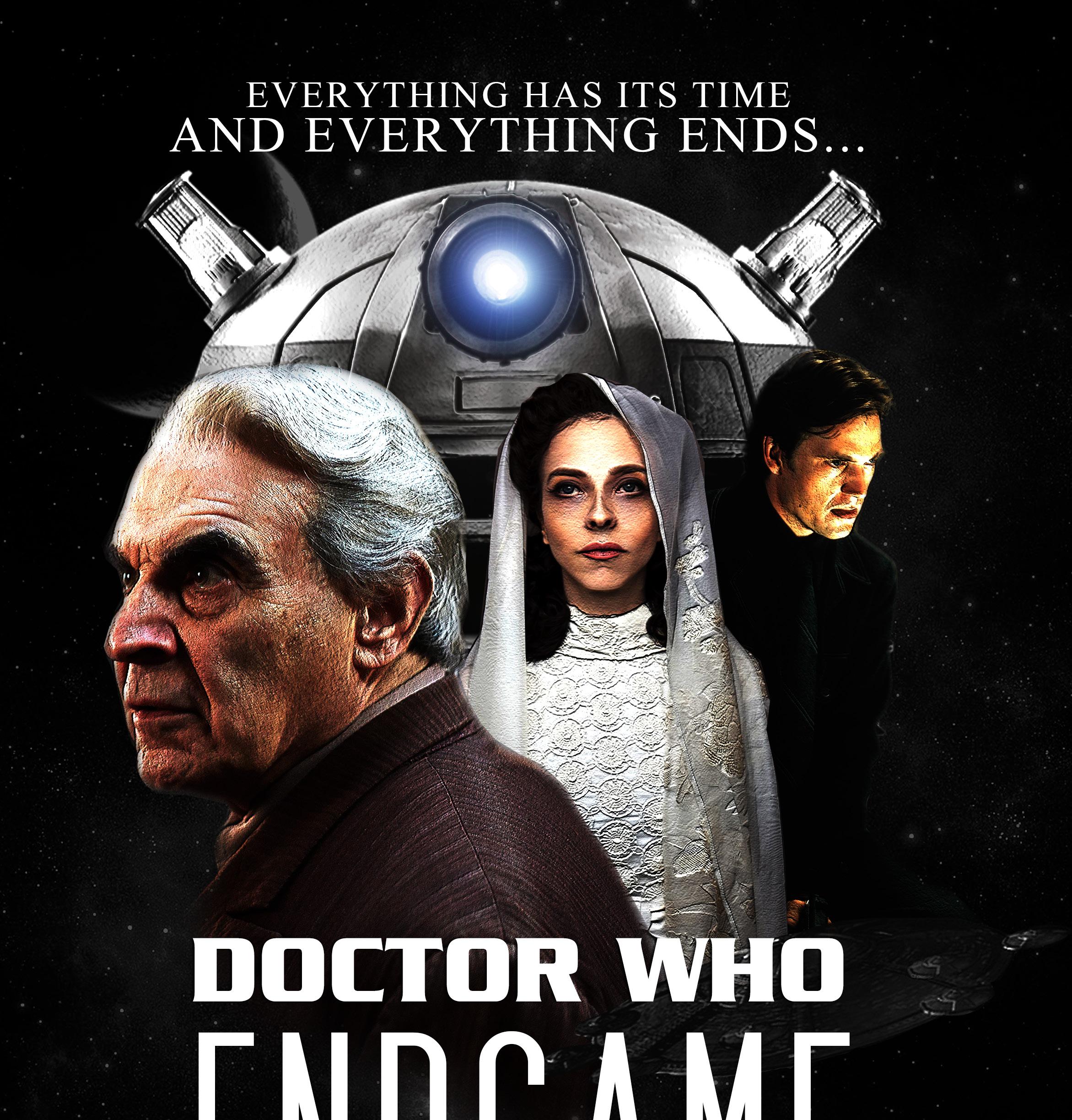
JACk MURRAY-BELL LOOkS RESPECTiVELY, FROM AN iN-UNiVERSE PERSPECTiVE, AT DOCTOR WHO’S THIRD MOViE FROM 2010 PAGE 32
like scavenger hunt type stories, and the show has done a couple of really good ones, but what made those stories good was the fact that we saw the TARDIS team traveling to different locations and having to overcome different obstacles. Here it's just them going to mines, getting chased away by Daleks, which is followed by an admittedly cool museum heist. Dokter Wie: Eindspel actually improved the story of this movie a lot.
Also one thing that's left as a bit of a mystery is the exact history of the Omega device: what exactly happened to it? How did the Valeyard get a hold of the exact parts requited to build it? and who originally built the device? It couldn't have been Omega, because he didn't become power hungry and mad until after the creation of time travel?
The Daleks are wasted in this movie: they're threatening; they kill a lot of people, but they're mostly reduced to shouty robots working for the Valeyard. We also don't learn why the Daleks have allied themselves with the Valeyard. Another problem I had was that I personally think it was really ageist not to bring Michael Jayston back as the Valeyard. I like Charles Dance as an actor, I really do, but it just feels wrong not to bring Jayston back when he was perfect-
ly available.
Speaking of the Valeyard: when the Supreme Dalek reveals that they've destroyed life on the first planet, the Valeyard seems to be disturbed by this, but nothing is ever done with the concept of him potentially being unhappy with the idea of killing, especially since he later gets a Dalek to kill Chris.
Now, let's get into stuff from the movie that I actually enjoyed.
As said, the Daleks are threatening, even if they mostly just serve the function of being henchman: Robert Shearman really knows how to make the Daleks scary. Chris's death was handled really well and I liked the funeral scene and its aftermath. While Chris's death is very sudden, I think it helps to show just how dangerous the Valeyard is, since he can pretty much get the Daleks to kill whoever he wants. The final fight between the Doctor and the Valeyard was awesome.
As for the ening to the movie, it serves as a good emotional gut punch. I'm embarrassed to admit that I hated the ending when I first saw the movie because I had this silly belief that protagonists shouldn't die, and that the movie was bad if they did; I had a similar reaction to the final Artemis Fowl book. I've since moved past that childish belief. I also love the Rogue's eulogy and the
Shearman really knows how to make the Daleks scary..."
sombre rendition of the Doctor Who theme in the end credits. Coincidentally, the final ever episode of Holby City used a sombre rendition of its theme song for its end credits ten years after Endgame's release; though Endgame was never intended as the final ever Doctor Who story, and I'm sure other shows have done a sombre rendition of their theme for the end credits, but Holby City's ending is what sprang to mind when preparing to write this retrospective.
As usual, David Suchet, Dougary Scott and Juliet Landau are on top form, Timothy Dalton is also great as the Rogue, who provides some much needed comic relief with the highlight being him being cut off mid-F-bomb. The final fight between the Doctor and the Valeyard was also really enjoyable.
Martin Campbell returns to direct and is great as always, as is Murray Gold, who returned to compose the score. His pieces suit the mood of whatever scene they're being used in.
Overall: Doctor Who: Endgame was quite decent, but definitely a downgrade from Vengeance. Join me next time when I'll be taking a look at the 50th anniversary movie, Doctor Who: Genesis WIDWWA

PAGE 33
"Robert





reAD everY IssUe of THE WIDWWA MAGAZINE AnD THE WIDWWA NEWSLETTER on IssUU AvAlIABle to orDer in print AT WiDWWA.co.uk WHAT If DocToR WHo WASN'T AXED? the MAgAZIne - the poDCAst All episoDes AvAliABle to listen to on the DDWf youTuBE cHANNEL As well As wherever you get youR poDcASTS




PART ONE

In the present day, a young woman in an expensive designer dress, Katie, walks up an illuminated driveway toward a mansion. She exudes confidence as she rings the bell and is swiftly let through into a lavish party. Katie moves through the crowd, with ease, finding her way to the staircase and making her way upstairs. Inside the master bedroom, she puts on a pair of long leather gloves, before removing an expensive painting off the wall, revealing an industrial safe. She smiles and sets about cracking it, which she does in a matter of seconds. Upon opening the safe she says that inside... is the Doctor, sitting in the safe, waiting for her.



The Doctor holds up a metal box and tells Katie that the back pearl necklace, that she was trying to steal, is inside it. She asks the Doctor to hand it over and he obliges. She then removes the necklace from the box, before placing the empty back into the safe. She then helps the Doctor get out of the safe, as he's a little stuck, before she slams the door shut, locks it, and places the painting back over it.
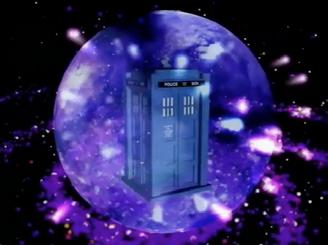
On their way out of the house but during this, an alarm is triggered. Soon, security begins chasing after them, with several German Shepards. The two manage to make it out of the house and shake off the security guards. Katie tells the Doctor that she'll bring her car round to him. We then see Katie getting the car... thinking for a moment and then driving off in it. The Doctor waits for her, checking his watch, before realising she's not coming. He then whistles softly and crosses the street toward a police box.
The following night, Katie stands in an alleyway, dressed in all black holding a large duffel bag of items. She opens the bag and checks it, pulling out a very familiar sword. The Doctor appears behind her, asking what possible reason she has for having that sword in her possession. Katie asks how he knows what it is but the Doctor is vague, just mentioning something about it being from Mars. Katie begins to apologise for abandoning the Doctor the previous night, but she suddenly feels the barrel of a gun aimed at the back of her head and looks around to see a very imposing man holding it. The Doctor tries to talk him down and asks Katie if this man is
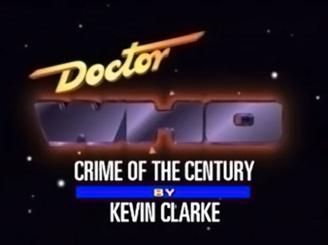
the one she's been waiting for. Katie says she has no idea who he is, and the Doctor suggests, not so subtly, that Katie use the sword. Katie does so and nearly kills the man, only stopping at just rendering him unconscious, because the Doctor stops her. Soon after, another man comes from the shadows, the man Katie was expecting... an older Sam Tollinger, who is surprised but overjoyed at seeing the Doctor and quickly explains that Katie is his daughter.
Sam explains to Katie that the Doctor is... the Doctor, the man whom he's always told her about. Katie is surprised to

PAGE 36
realise that he's a real person, and the Doctor just elusively responds by claiming that he could be entirely fictional. Sam explains that since he last saw the Doctor, most of his stranger possessions were seized from him by UNIT, to which he was highly compensated, but over the years, they became declassified and most of them managed to find their way to the black market. Most of them were bought by members of the aristocracy and that's what Katie's been stealing back, ever since. However, one item, the jewelled egg was taken off UNIT by the Government and they've been unable to track it down. Sam asks for the Doctor's help in getting his property back, and the Doctor agrees. The Doctor then looks in the duffel bag and pulls out the necklace. He hands it to Katie and tells her that it belonged to her mother, and she should have it. Katie cries, upon seeing it, and hugs the Doctor thanking him.
The trio then roam through the backstreets, as Sam catches up with the Doctor about their family history, since they last met. The Doctor takes a keen interest and says that he's there because he noticed that they'd been a series of thefts all relating to items in Sam's possession, and decided to investigate. Sam asks about how he is now Ace is gone and the Doctor is cagey about the issue, refusing to give Sam a proper answer. They eventually reach the TARDIS and the Doctor smiles before opening it... revealing the new interior to the audience for the first time too.
Katie steps in and is amazed as she looks around in disbelief... The Doctor chuckles as the two enter and says that the TARDIS should be able to give
them some idea of where the government is holding the jewelled egg. The Doctor conducts a scan and manages to locate traces of it at a military base in Scotland. He then dematerialises the TARDIS... to Katie’s shock.
Soon after, the TARDIS arrives inside the military base. The Doctor, Katie and Sam step out, only to see a series of lasers appear in front of them and an alarm sound. Then, to make matters worse, a group of armed guards appears beyond the lasers. The Doctor clutches his umbrella and says "Ahhhh..."

PART TWO
TheDoctor, Katie and Sam are taken by the security guards to an office, where they are told to wait. During this time, Katie tries to formulate a plan to override security and continue into the compound. Sam says it’s far too dangerous and she’s being foolish. Katie remarks, “Foolish is my middle name, Daddy” to which he says, “No it’s not, it’s Raine”. Soon after, a small man in an army uniform with a cockney accent, Corporal Salter, enters the room and sits down in front of them. He says that he’s checked the records and that he’s now fully aware of exactly who the Doctor is and that he’d be delighted to give him a tour of the facility. The Doctor jumps up and says that’s excellent and tells Katie and Sam to come along. Salter stops them and says that they stay there, as they have no authorisation.
The Doctor and Salter leave the office as they begin a tour of the compound. Salter explains that he used to work for
UNIT, back when he was Scientific Advisor, and lists off a bunch of events from the era. He then admits to the Doctor that he’s breaking several dozen rules letting him through security and he’s only doing it because he trusts him. The Doctor thanks Salter but asks why… what is so important about the compound. Salter says that this compound was set up privately by the government to hold the most dangerous extraterrestrial weapons, taking them out of the hands of organisations such as UNIT. He then explains, however, that he believes the government are up to something, as he’s noticed items vanishing from time to time with all record that they were ever at the facility also gone. The Doctor holds his umbrella up, showing off the question mark, while thinking. The two then come to the place where the jewelled egg should be… only to find it gone.

In the office, Katie picks at the lock, trying to force it open. Sam tells her to be gentle with it and that picking a lock is a delicate art. Katie snaps at him saying that she is capable of doing things on her own. Katie, still having no luck, stops for a moment, smiles, and then proceeds to pick it differently, and more calmly. The lock suddenly clicks and the door opens to which Sam smiles and tells her to follow him.
Inside the TARDIS, the Doctor and Salter scan for the whereabouts of the jewelled egg. Salter says that it was only there a few hours ago and that he saw it himself. Salter asks the Doctor what’s so special about the jewelled egg, to which the Doctor says that he’s the governor of a high-classified government security compound and he doesn’t know… The Doctor
PAGE 37
then explains that the jewelled egg, or as it’s really known the Virumun, is a very ancient and very deadly weapon… it has the power to remove things, objects, people or even entire planets from existence. Salter looks terrified and says, “and that’s what’s been stolen!”. The Doctor then explains that it’s powerless without a microfilament transponder wave generator, but that even the Ice Warriors couldn’t invent one of those. The Doctor then exclaims that he’s found a match and it seems to be in Birmingham. He then sets the TARDIS into flight and it dematerialises.
Katie and Sam sneak through the compound, avoiding the guards, as they search for the jewelled egg. Along the way, they spot a number of other very expensive looking items and quietly steal them, because “they might as well”. They search and search but can’t find the jewelled egg.
The TARDIS lands in a backstreet in Birmingham outside an incredibly anarchistic posh-looking private members club. The Doctor and Salter walk in, to which the receptionist asks their names. Salter says that he’s “Corporal Anthony Salter” and the Doctor jumps in and says his name is, in a very thick exaggerated Scottish accent, “Doctor Fergus Ansley McCarthy-Frazier”. The receptionist smiles and checks the members list saying that she doesn’t have any record of their membership. The Doctor then looks around and notices something unusual… a portrait of the club’s founder… Hans de Flores. The Doctor and Salter leave the club and go back into the TARDIS. The Doctor then tells Salter that he knows who stole the jewelled egg... A Neo-Nazi group, founded by one
Hans de Flores. The Doctor explains that he encountered them a couple of years ago, during a run-in with the Cybermen, and that they must’ve remobilised and found some sort of “in” with the government. Salter says that this is indeed very troubling information and that the entire government could be compromised.
Katie and Sam conclude that the jewelled egg isn’t in the compound and that the Doctor and Salter seem to be gone. They quickly discuss what to do before they decide on breaking out, with their stolen items, and making their way back home. Elsewhere we see a group of security guards checking a list of items and looking at the shelves, seeing that (the ones Katie and Sam stole) are gone. They sound the alarms, causing a chase sequence to ensue, as the guards try and catch Katie and Sam.
Salter tells the Doctor that it’s of vital national importance that they get inside the club and the Doctor agrees. He says that he should be able to materialise the TARDIS inside, as long as he can get a better lock on the Virumun.
Katie and Sam just about make it out of the compound when a guard, Sergeant Becker, springs out in front of them. He holds out a gun and tells them to drop the bag. They do so and more guards join them. Becker grabs the bag and looks through it, saying its remarkable how they managed to choose about every item he had on his list.
The TARDIS lands inside the club, as a group of men dressed in SA brownshirt uniforms, grabs their guns and surround the TARDIS. The Doctor and Salter step out of the TARDIS. Salter then smiles.


Becker unzips his guard uni-
form to reveal that he, and the other guards at the compound, are wearing brownshirts and are working for the Fourth Reich. Salter steps forward, to which the Doctor asks what he’s doing, before he turns around joining the guards, taking off his army uniform, to reveal a similar, more senior, SA uniform below. He then speaks loudly, in a German accent, telling the Doctor that the Virumun was just a lure and that now the Fourth Reich have in their possession… the greatest weapon of all. The camera zooms in on the TARDIS as Salter says: “We now posses time travel!”

PART THREE
Inside the compound, Becker and his brownshirts continue to aim their guns at Katie and Sam. After a moment of pause, Katie shouts out in German (subtitled in English) “you boys have been doing a really great job, but now it’s time for the professionals to take over”… before turning sharply on her
PAGE 38
heel and telling Becker that she’s Unterführerin Tollinger and she’s been sent there, along with her assistant, to retrieve items directly for the Führer.

Becker tells her that her German is excellent but he’s well aware that she’s not a member of their ranks raises arms once again. Katie says that it was worth a try to which Sam asks, in confusion, “since when did you speak German?”. Katie says, “You sent me to a bording school in Switzerland, try to keep up, Dad…”
Inside the TARDIS, Salter tells the Doctor to take him and his men back to the compound. The Doctor says the whole plan is a pointless exercise because they can’t just go back in time and just quietly change the course of history so that the Nazis won the Second World War. He says that it’s not as simple as that. He then asks what they suppose they’ll do… seriously. What is their “big” plan to change the outcome of the war? Salter laughs and then says it’s called
the Virumun. The Doctor then reminds Salter that without a microfilament transponder wave generator, the Virumun is useless. Salter tells the Doctor that he thanks him for that information and soon he’ll have an entire compound of alien artefacts at his disposal to build one for them. Salter also tells the Doctor that there’s no point playing the fool, he really was at UNIT, and he knows just how skilled the Doctor is at this kind of thing.
The TARDIS lands in the compound, just saving Katie and Sam in the nick of time. Becker salutes Salter as he exits the TARDIS, his gun pointed in the Doctor’s back. Salter tells his men that the Doctor will be building them the final missing part of the Virumun. Katie tells the Doctor that he can’t, and these people are “literally Nazis”. The Doctor tells her that he has no choice but to do what the Corporal says. Salter corrects the Doctor and asks to be called Führer Salter. The Doctor tells Salter that if he’s going to do this, he’ll need Katie and Sam’s help. Salter agrees before telling the Doctor that he has three hours and leaving.

Left alone, but aware that they have guns trained on them, the Doctor catches Katie and Sam up with everything and says that he thinks Salter is planning to erase significant figures on the Allies’ side, during the Second World War, to change the course of the war, using the Virumun. The Doctor says not to worry because he has a plan. He asks Katie whether she could open “one more safe” for him. Katie cheekily smiles.
Katie approaches Salter and tells him that there’s another device the Doctor needs in order to complete the weapon and

that she’s been asked to steal it. Salter says that if she goes with Becker and his men, then she, of course, can do so. Katie tells him that it needs to be just Becker, as they need to stay incognito.
Sometime later, Katie, dressed once again in an expensive designer dress, down a path with Becker, dressed in a designer suit, pretending to be a couple… it’s slowly revealed that the building they’re walking into is Balmoral Castle and a party is taking place. Katie asks Becker “how is your RP?” to which Becker responds in an RP accent saying it’s “absolutely spiffing”. They get to the door of the castle and Katie says that she’s Katie Tollinger, daughter of Sir Samuel Tollinger, friend of the Princess Royal, and Becker is her Plus One. The guard says “of course” and let’s her right in. Katie then remarks that sometimes having a rich dad really makes all the difference.
The Doctor and Sam continue to build the device, while they discuss Katie. Sam says that he struggles to connect with her, he says that she’s so independent and just wants more constantly. The Doctor says that she reminds him an awful lot of someone else… Sam soulfully nods saying that it makes it even the more painful.
Upstairs in Balmoral, Katie and Sam come to a heavily fortified door, which Katie easily picks the lock of, and inside they find a glass case and a crown inside. Katie says that it’s the Queen Mother’s crown and what they need is the Koh-i-Noor diamond that’s sat on it. Becker proceeds to grab the cage but suddenly lasers appear around it. Katie rolls her eyes and says and he needs to just leave her to it.
The Doctor just about com-
PAGE 39
pletes the device and says they only need to Koh-i-Noor and it’ll be done. Salter impatiently comes toward them and asks when it’ll be ready. The Doctor repeats to him that it’s done and they’re just awaiting the diamond. Salter looks unhappy and says that Becker better hurry.
Katie intricately tries to get the Crown out of the case, without tripping any more alarms but she struggles with Becker watching over her. She says that he just needs to stand outside and guard or something because she can’t do it properly with him there. He argues but Katie asks if he really thinks she can escape him from the top of Balmoral Castle in its most secure room. Becker says that’s a good point and then proceeds to leave and wait outside. After a moment, Katie smiles before purposely tripping every alarm she can. In seconds, guards rush and arrest Katie and Becker and it’s not long until they find a swastika on Becker’s person.
Salter is told by a brownshirt that Katie and Becker have been arrested. He looks furious and stomps over to the Doctor and grabs the device. He points a gun at the Doctor and Sam and then herds them into the TARDIS. He tells the Doctor that he wants to go to England in 1943. The Doctor obliges and dematerialises the TARDIS.
Katie and Becker sit in a police interview room, as Becker gives her the evils the entire time. Once a police officer walks in, Katie explains to him that Becker is a Neo-Nazi and that she’s working with her father, Sir Samuel Tollinger, and a staff member at UNIT to bring them down and this was all a trap. The police officer just laughs in her face.
The TARDIS lands in 1943 and

Salter steps out with the Virumun. He sets it on the ground, just in front of him, and tells the Doctor to hand him the microfilament transponder wave generator. The Doctor says that he’s making a mistake and Salter exclaims that he was right about the Koh-i-Noor being a diversion and that the device works just fine without it, considering the Doctor is so worried about him activating it. The Doctor and Sam step back into the TARDIS, slowly, as Salter combines the two devices. He then activates it, and it engulfs him as he screams. Slowly, Salter vanishes… from existence. Sam looks at the Doctor and says that was horrific. The Doctor explains that without the Koh-i-Noor, or just some sort of stabilising receptor, which he chuckles and says could’ve simply been the graphite in a pencil, the microfilament transponder wave generator was only a microfilament wave generator, thus causes it to backfire on Salter.
Some time later, the Doctor, Katie and Sam sit down drinking tea in the sitting room of Sam’s mansion. They are watching the news where there’s a report about a secret Neo-Nazi group being apprehended after they attempted to steal the Kohi-Noor diamond from Balmoral Castle. Katie comments that she was in that cell for hours with Becker before UNIT came to her rescue. The Doctor apologises but says it was the only way to bring down the whole operation. The Doctor and Katie have a good laugh about it before Sam looks over at Katie giving her a bit of a nudge. Katie then asks the Doctor, rather uncharacteristically shyly, if she could join him on his adventures. The Doctor jumps up out of his chair, spilling his tea, and grabs her
hand saying of course and drags her into the TARDIS. He then pops his head out of the door and says goodbye to Sam, before closes it again as the TARDIS dematerialises.
DEVELOPMENT
The story for Crime of the Century began as an idea for a sequel, by Kevin Clarke, to his first (and only) Doctor Who story, Silver Nemesis. The idea was about the remnants of de Florres' Fourth Reich using an ancient weapon in UNIT's vaults to change the course of the Second World War. The idea, while briefly considered by Cartmel, was dropped very early on and it was only after other plans fell through that Cartmel revisited it, with the (now) added stipulation that it had to introduce a new companion, in the form of Katie Tollinger, be set in a mansion and include an opening scene of the Doctor in a safe, which Cartmel had already come up with.
Following the first draft, Cartmel suddenly hit on the idea of linking up Crime of the Century, and it's predecesor, Ice Time, into a psuedo 7-part adventure, with the Katie's father becoming Sam from Ice Time (and his surname changing to Tollinger accordingly) and the primary plot mcguffin being linked to Ice Time as well.

PRODUCTION
The most significant aspect of Crime of the Century's production was that it introduced a brand new TARDIS interior for the series. By the end of Season 25, the TARDIS set
PAGE 40
had practically fallen apart, so in Season 26, due to a lack of money, the inside of the TARDIS didn't really feature. For Season 27, John Nathan-Turner managed to organise things so that a new TARDIS interior could be built, debuting in Crime of the Century but shot as part of the studio shoot for the following serial, Blood and Iron, as Crime of the Century was designated to be all-location. Originally, Blood and Iron was going to feature the debut of the interior, but Cartmel wished to be able to show Katie's first reaction to the TARDIS, so it was moved a story earlier.
The set was designed by Mike Tucker and featured the unique feature of the TARDIS' central column suspended from the ceiling. The set was built so that

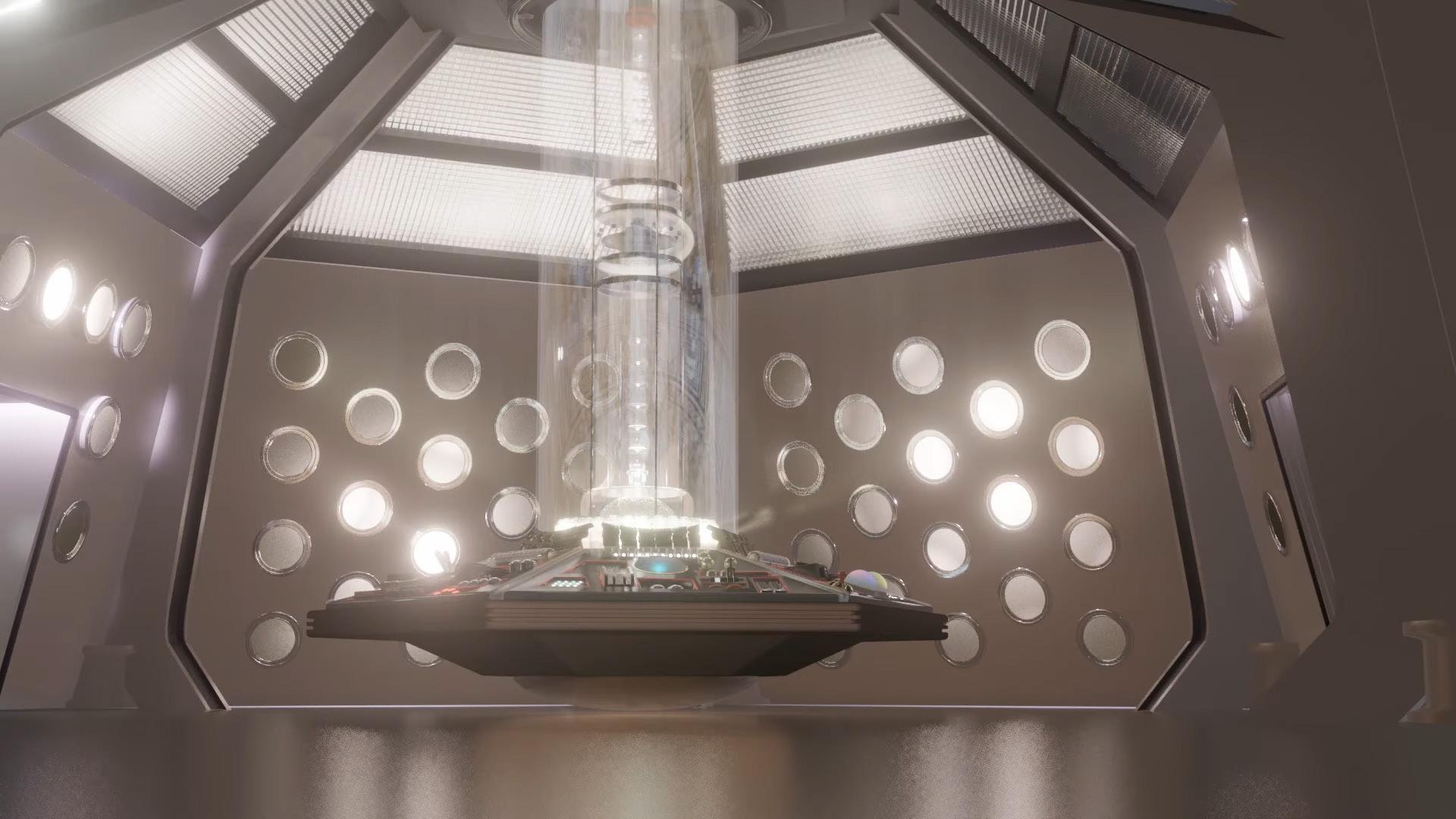
the height of the console could be adjusted based on who was using it, future-proofing it for the next actor to play the Doctor..

The actual story itself became prone to John Nathan-Turner's often desire to stunt cast guest roles. From Beryl Reid in Earthshock to Nicholas Parsons in The Curse of Fenric, and everything in between, Nathan-Turner loved casting famous faces, especially to the BBC One Light-Entertainment viewer, in rather unexpected Doctor Who roles. This time actor and comedian David Jason, best known for his roles in, sitcoms, Open All Hours & Only Fools and Horses, was cast as Corporal/Führer Anthony Salter, the main villain for the story. Jason was required to play
a loveable cockney army officer and then transform into a Nazi with a German accent. Jason indeed rose to the challenge but he certainly didn't play it straight, instead sending up the role, chewing the sceneary at every turn and, on set, spent most of it messing about with Sylvester McCoy.
Although only in one scene, the set for the Tollinger's sitting room had a lot of money spent on it due to the fact that Cartmel intended the Tollinger's house to be a recurring set, from the next season, becoming a "base of operations" for the Doctor and Katie, a bit like the Doctor's lab back in the Pertwee years. Cartmel wasn't to know that perhaps the incoming production team had different plans... WIDWWA

PAGE 41
“David Jason was required to play a loveable cockney army officer and then transform into a Nazi with a German accent.”
The Eighth Doctor
The casting process for the Eighth Doctor began fairly soon after Michael Wearing appointed Ian Fraser as Doctor Who's new Producer. Fraser had yet to formally take over and still working as a Production Manager on Season 27, most notably on Blood and Iron which allowed him to oversee the transition to his premiership with ease.
Previously, the incumbent producer had always cast a new Doctor, even if they knew that another would be producing the show by the time they'd begin working with them for a full season. Nathan-Turner decided, after having cast three Doctors, himself, that it wasn't his place to cast a fourth and enthuastically granted Fraser permission to use the Doctor Who Production Office to begin the process of casting the next Doctor.

Without a new script editor appointed, Cartmel liased with
Fraser, through this period, as they worked out what sort of character their new Doctor would be. This brief was handed out to the neccessary agents and the interested ones, with actors, who they represented, in mind, replied and auditions were set up.

Following a rigiorous audition process, which also had to be overseen by Michael Wearing and Jonathan Powell, Richard Griffiths was awarded the role. Griffiths had initally been considered for the role of the Fifth Doctor, a decade earlier, but Nathan-Turner just preferred Peter Davison when it came down to it. Griffiths, in the intervening decade, had vastly expanded his career with apperances in "Chariots of Fire" (1981), "Gandhi" (1982) and "Withnail & I" (1987), as well as earning a BAFTA nomination for TV Series, "A Kind of Living" (1987). Griffiths impressive CV certainly gave
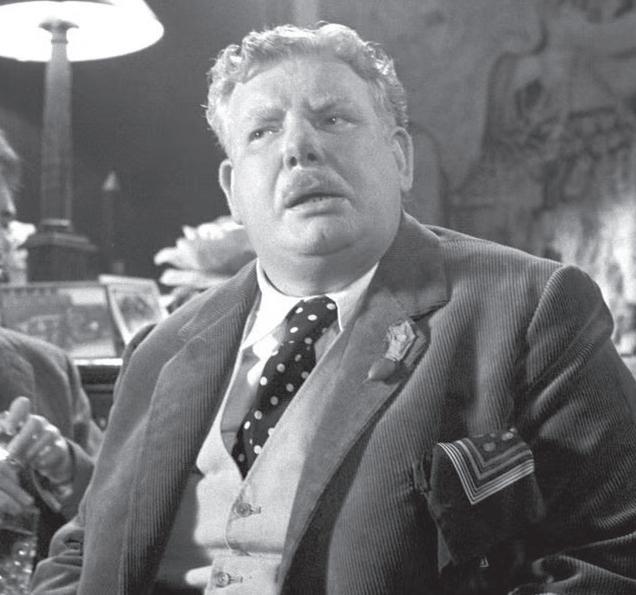
1990, just under a month before the beginning of Season 27 airing, Griffiths was announced as the Eighth Doctor. At this time, Blood and Iron was wrapping up production, and Griffiths travelled to BBC Television Centre to film his end of the regeneration.
Following this, it'd be another six months before Griffiths would step into the role full time, when production on Season 28 began...
WIDWWA
PAGE 42
PART ONE
Ina jungle, Brigadier Winifred Bambera and a group of UNIT soldiers enter an alien spacecraft. They pan out and search it, finding absolutely nothing inside… it’s deserted. Bambera then looks around the edge of the ship and notices several strange plants. One of the UNIT soldiers touches it and is instantly turned into a skeleton. Bambera tells everyone to stay clear and they have a “code nine”.
In the TARDIS, the Doctor tells Katie all the amazing places they could go, but Katie seems rather unimpressed instead asking about the facilities on the TARDIS. The Doctor is rather taken aback when Katie asks for details such as whether he has a shower or bath, how big is her bedroom, how many clothes can she get into her wardrobe. He tries to explain to her that the TARDIS is a dimension of infinite space and that her human mind just can’t wrap her head around it. Katie is offended by this and says that “she’ll see about that!”. An alarm then goes off in the TARDIS, which startles Katie, but the Doctor says it’s nothing to worry about and it’s just that UNIT need
their help: 2001, Margrave University. Katie suddenly becomes very excited about the prospect of travelling 11 years into the future.


The TARDIS lands at Margrave University, which has dozens of portacabins, with the UNIT logo, set up outside it. Bambera comes to greet the Doctor and thanks him for answering her call, especially because she only sent it a few seconds ago. The Doctor takes off his hat and pats the TARDIS saying that she’s behaving at the moment. Bambera chuckles and tells them to follow her.

Bambera takes the Doctor and Katie to a greenhouse at the university, but before entering tells them they need to get into hasmat suits for their own safety. They do so and go inside. Bambera explains that the plant in there was found by an alien spacecraft in the middle of the jungle and it has the most terrifying properties. She then takes out a small metal case, opens it and pulls a mouse out by it’s tail. Katie looks nervously at her before she chucks it at one of the plants… instantly the mouse becomes a skeleton. Bambera says that initially they only found this out because one of their own soldiers was reduced to bones. Katie is horrified and
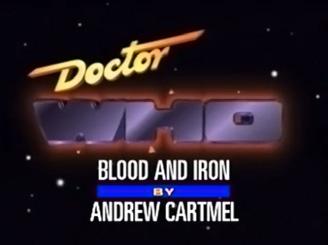
the Doctor says that he’s seen enough and asks to continue the conversation elsewhere.


In one of the portacabins, Bambera explains that UNIT have partnered with Margrave University to find a way of controlling the plants to be used for good. The Doctor questions what “for good” means and Katie asks if “for good” includes purposefully “skeleifying” mice. Bambera comments that she sounds like “one of Scobie’s lot” before she has an idea. She radi-

PAGE 43
os “Sergeant Henrick” and asks him to come to the portacabin. Soon a fresh-faced UNIT soldier bursts in and salutes Bambera. Bambera explains that she thinks it would be a good idea for Katie to go undercover at the university, as she’s worried about something compromising taking place there, and says that Sergeant Henrick will join her. Katie says that surely the students will recognise Henrick, but Henrick assures her that as long as he’s out of uniform they won’t even realise he’s been there for weeks. Katie is weary about agreeing but the Doctor says she’ll fit right in, and she’ll have fun. As Katie leaves the portacabin with Henrick, she comments that it’s “hardly Oxford” …

The Doctor continues his conversation with Bambera, alone, where he tells her that he’s seriously concerned about the ethics that UNIT are employing here. Bambera tells him that it’s “orders from above” and these plants could be a golden bullet… The Doctor nods and says that he knows and that’s what worries him.
Some time later, Katie and Henrick enter a seminar, dressed in casual clothing. A girl called Willa comes up and introduces herself to them, asking where they’ve been all term. Thinking fast, Katie responds in her German accent, that she and Henrick are exchange students and are joining them for a few weeks. Willa quickly accepts this and invites them along to a meeting that evening that her boyfriend, Ray, is running. Katie politely declines, but Henrick jumps in (with a far less convincing accent) and says that they’d love to go. The seminar begins, which is about the carnivorous plants that the univer-

sity is investigating.
The Doctor and Bambera return to the greenhouse where the Doctor inspects the plants for himself. He says that he doesn’t recognise the species at all, and he thinks there’s a good chance that the species has been significantly genetically modified by a group of alien scientists. Bambera says that UNIT have come to the same conclusion and that they think if the plants have already been genetically modified by scientists, then the same can happen again.
Katie and Henrick arrive at the meeting in a hall and see Willa with her boyfriend, Ray Scobie. He’s telling all the 10-ish people there about an aerial that he has built which might be able to contact the people that they need. Willa sees Katie and Henrick and comes to greet them, telling them to sit down. They watch and see that Ray is an animal rights activist and thinks that the plants were made to kill any animal that eats another animal.
After the meeting, Ray and Willa approach Katie and Henrick and ask them to follow them. They do so and enter a series of underground tunnels. Ray explains that they’re fairly secret and even the “UNIT buffoons” don’t know they exist. Katie and Henrick laugh along but he then turns around with a gun and says “Well, I suppose the UNIT buffoons do now I’ve told them, but not for long”… And all the joy quickly disappeared from Katie and Henrick’s faces.
PART TWO
Katie drops the German accent and explains to Ray and Willa that she and Henrick are indeed working for UNIT
but that she has a lot of sympathy for his cause. She doesn’t agree with turning the plants into weapons and she certainly doesn’t like the animal testing. The Doctor takes Bambera into the TARDIS where he shows her his analysis of the plants. He says that they seem to be mainly converting the blood of the creature it kills into some sort of iron and then absorbing rest, but the skeleton. Bambera asks if the plant lives off iron, but the Doctor looks at the readings and says that’s the bizarre thing… it just disposes of the iron right away. He says that it’s purposely collecting something just to immediately dispense of it.
With guns on Katie and Henrick, Ray tells them to plant explosives underneath the UNIT portacabins to prove their loyalty. Henrick says that he won’t and there’ll just be killing innocent people for no reason. He questions why Ray stands up so much for animal rights when he’s prepared to kill humans. He responds by telling Henrick that those who torture, kill and con-

PAGE 44
sume animals don’t deserve any mercy. He then reloads his gun and insists that they plant the explosives… but just then Willa whacks Ray around the head, from behind, knocking him unconscious. She tells Katie and Henrick to run and she’ll deal with him.
Katie and Henrick burst into a portacabin to find Bambera and the Doctor continuing to investigate the plants. They bring the two of them up to speed and they take special interest at Ray’s theory about only meat-eaters being killed. The Doctor then proposes that perhaps the plants are a method of creating some sort of meat substitute, from the blood of meat-eaters and then converting them for herbivorous creatures. Bambera says that surely, by definition, they’re carnivores if they’re killing humans to eat. The Doctor agrees that something isn’t adding up here.
Ray wakes up in the university, with Willa at his side. He asks her what happened, and Willa explains that Katie and Henrick overpowered him. He then says that they have no time to waste and must activate the antenna then. Willa asks if that’s such a good idea as he doesn’t know who’ll be at the other end of it, but Ray insists that he does, and it’ll be some very like-minded people.
Katie explains to Bambera that Ray is unhinged and plans to blow up the portacabins. He isn’t happy with UNIT using mice to test the plants and frankly neither is she. Bambera then has an idea and suggests using a species of omnivores, such as millipedes or beetles, and see if they are killed. Katie interjects and says that defeats the purpose and says that UNIT need to stop using animals to test this deadly
weapon on. Henrick then reiterates that Ray is planning to blow up the portacabins that they’re in and maybe, just maybe, they have enough evidence to arrest him now.
Henrick leads a group of UNIT soldiers to find Ray Scobie and arrest with, with the Doctor, Katie and Bambera following shortly behind.
Ray activates the aerial which emits a signal out into the stars. He smiles and tells Willa that finally humanity will evolve past the need to consume animals… and any that do will be rendered into skeletons. He then tells Willa to follow him as he heads to the greenhouse.

Outside the greenhouse, UNIT catch up with them and tell Ray that he’s under arrest. Ray, however, without a hasmat suit steps into the greenhouse… and UNIT can’t follow him. They all look terrified, but Ray is fine. He touches all the plants and is unharmed. He exclaims that he is a herbivore and will not be hurt, unlike the others before manically laughing.
Then suddenly the glass of the greenhouse shatters, as a spaceship enters the atmosphere. The plants begin to move out of the greenhouse, escaping into the rest of the grounds. The spaceship comes down from the sky and lands next to the antenna. The door opens and the Numlocks step out.
PART THREE
TheNumlocks introduce themselves to UNIT and Bambera asks them to stop their plants from leaving the greenhouse. They oblige and the plants retreat back inside. The Numlocks ask to examine their ship… the one that crashed.
Bambera says that it is still in the jungle. The Doctor offers to accompany the Numlocks inspecting it and tells Katie to join him. The two of them board the Numlock ship which travels to the location of the crash site.

On the ground, Bambera has UNIT soldiers dress in hasmat suits and arrest Scobie, who’s been sheltering amongst the plants thus far. He’s taken to an interrogation room where Bambera questions him. She essentially manages to summarise that Scobie is just a mad scientist who has ideologically aligned himself to a cause.
On the Numlock ship, the Doctor speaks to their leader and asks what the purpose of the plants is. The Numlock leader explains that they are herbivores and on their home world there’s a large amount of unintelligent insect and rodent life that are carnivores. In order to supplement their diet, they developed the plants to grow in the wild and collect the necessary supplements from the insect and rodent life and transfer it into the wider population. They explain that the plants were never meant to come to Earth, and they don’t know why their ship crashed.
Willa speaks to Scobie in the interrogation room and he tries to persuade her to let him free. She tells him that she can’t do that and she agrees with UNIT that he went too far. She agrees that animal testing needs to be stopped and she says that she’s a vegetarian but killing people who have a different view is not the answer. She says it’s tantamount to genocide.
Henrick helps Bambera and the other soldiers with patching up the greenhouse and keeping the plants closed in. Henrick notices that they’re behaviour
PAGE 45
seems different now and that they’re more at ease.
The Numlock ship lands in the jungle and the Numlocks, alongside the Doctor and Katie, investigate the crashed ship. The Numlock leader comments that the plants were rooted out with force and says that it’s rather upsetting the way they were treated. The Doctor sympathises and makes a comment about the brutality of humanity. They inspect the ship and the Numlocks ascertain that it was shot down and they suddenly become very angry. The Doctor tries to calm them saying that he, himself, isn’t human and that they can trust him. The Numlocks say they were transport the remnants of the ship into their cargo bay and then return to the University, where they’ll be making significant demands.
The Numlock ship lands at Margrave University again, shattering the newly repaired greenhouse, once more. Bambera and Henrick come out of the portacabin to meet them and the Numlocks explain their find-

ings. They then say that in exchange for not declaring war on Earth, for shooting down their ship, they have a few demands. Firstly, they say that they want all laboratory animals freed. Bambera says that planet wide that couldn’t happen straight away, but they can make a start at Margrave University, to which the Numlocks agree. Secondly, they say that they want their plants returned to them, which Bambera agrees to easily. Finally, they say that they are a race of scientists and they’d like to study human physiology and ask to study a sample of humans at the university, for the pursuit of science. Bambera is cautious but ways up allowing this or facing war with the Numlocks and agrees but says that Henrick will supervise the process and the lead Numlock assures him that the humans will “come to no harm”.
Bambera and the UNIT soldiers set about fulfilling the Numlocks demands, while the Doctor and Katie return to the TARDIS to discuss matters. The Doctor asks Katie if she’s thinking what he is and they both say that remnants of the Fourth Reich might still be within the government and they were the ones who shot down the Numlock ship. The Doctor says they should investigate and Katie suggests Downing Street might be a good place to start… and wonders who the Prime Minister is now. The Doctor sets the TARDIS to dematerialise and it begins to… but then it fails. The Doctor tries again and again but it keeps failing. He then looks at the scanner and sees that the Numlocks have imposed a forcefield around the university.
The Doctor and Katie run out of the TARDIS and into the Numlock ship, where dozens of

people have already had samples of their blood taken. The Doctor tells Henrick that the Numlocks are up to something. At that moment the lead Numlock turns around and tells the Doctor “yes we are” and laughs before saying “did we say that the humans would come to no harm, well we meant they would come to… know… harm!”. They then activate a machine and suddenly dozens of people around the campus turn into skeletons and the Numlocks feed and feed…. And they laugh.

PART FOUR
The Doctor tells them that what they’ve just done is mass murder. They say that they will continue this “mass murder” on a planet wide scale and the Doctor will help them. The proclaim that Earth will become their new breeding world. The Doctor says that Earth is protected and that won’t happen on his watch. The Numlock then smiles and offers the Doctor a syringe saying that maybe instead he’ll offer them some of his blood. The Doctor politely declines and leaves the ship.
Bambera and the rest of the soldiers all have their guns at the ready, having just seen all those people turn to skeletons. The Doctor says that they have to find a way of disabling these plants because the Numlocks almost certainly have the means to distribute them across the entire planet causing mass genocide. Bambera says that the Numlocks have taken the plants off UNIT now and they can’t continue to analyse them but Katie remarks that they could try asking a certain someone’s help.
Katie, alone, enters Scobie’s
PAGE 46
cell. She tells Scobie the situation and Scobie just laughs saying that if most of humanity is killed for eating animals then “it serves them right”. Katie tries and tries to appeal to him telling him that she knows deep down he is a good person. She says that the Numlocks could’ve taken him with them, as an ally, but they chose not to because they don’t see him as important. He isn’t really one of them and he isn’t edible. She says that they think he’s useless whereas UNIT see him as the most useful person on the planet at the moment. Scobie looks at her and considers this deeply. He is flattered by the attention but still doesn’t know if he can help UNIT. Katie leaves and tells him to think about it.
The Doctor speaks to Bambera and Henrick about his theory of deep corruption rooted in the government and that the Fourth Reich are somehow operating from within. Bambera is sceptical but points her to several (fictional) incidents throughout
the 1990s which support this theory. He asks Bambera and Henrick to investigate this while he deals with the Numlocks.
Willa enters Scobie’s cell, being sent by Katie, and appeals to Scobie personally telling him that if he won’t do it for UNIT then do it for her. She tells him about all their loved ones who eat meat, who they don’t agree with, but they do love and whether he’ll let them be killed and just turned into nutrients for a bunch of aliens. Scobie eventually breaks and hugs Willa telling her that she’s right.
Scobie and Willa join the Doctor and Katie in the portacabin as they set to work trying to nullify the plants. Scobie hands over a sample of the plant, which is place in the middle of the table, that Scobie explains he kept in his pocket. Using his knowledge and testing on the plant, they develop a working theory. However, to enact they would need blood genetically modified in a way that regenerates itself fast. The Doctor says that his blood does that already, as he is a Time Lord.
Bambera and Henrick drive to the edge of the University campus in a jeep and then come to the forcefield. Henrick takes out a device from the back of the jeep and activates it which creates a small temporary hole in the forcefield enabling them to leave.

The Numlocks set their ship into flight and hover it above England, before releasing thousands of seeds out of the bottom of the ship and then landing at the university again. Quickly, their plants begin to grow all over the country.
Scobie takes a sample of the Doctor’s blood and adds multiple chemicals to it in a test tube before squirting it over the plant
sample on the table. He then asks Katie to touch it. She is nervous and says that maybe it’s better to just test it on a mouse. Scobie shouts out “over my dead body” but Katie says the trouble is that it can’t be his and instead its hers. Nervously, Katie does so and she’s fine. The plant has been nullified. But simultaneously, the Doctor’s face flickers to a skeleton for a moment but then returns to normal. The Doctor says that it’s as he feared and if they use that formula to nullify the plants worldwide, then he will die. Katie tells him that he can’t, but the Doctor says that it’s a worthy sacrifice and explains that he, as a Time Lord, has the ability to do something called regeneration. Katie is incredibly upset but understands.

In London, Bambera and Henrick search some records at MI5, and they notice a pattern in certain names making certain orders. They make a list and issue it to the Head of MI5. He is very concerned to hear of such a conspiracy and agrees to their arrest. They also see evidence that one of these names did order the shooting down of the Numlock ship. The names on the list are arrested and with the information now highly classified, Bambera and Henrick return to Margrave.
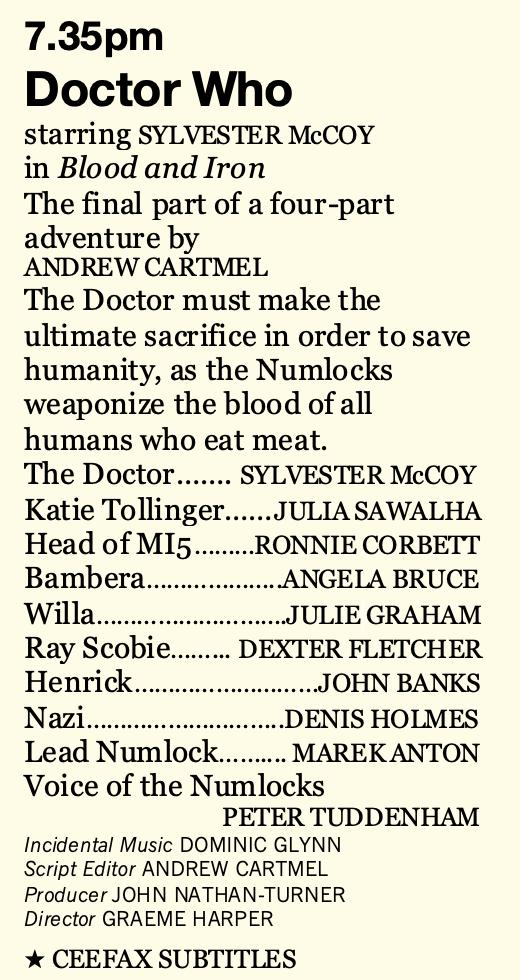
In the portacabin, Scobie takes several pints of the Doctor’s blood and treats it with the same chemicals as before. Meanwhile they’re informed of reports coming in that people are starting to be killed by the plants, nationwide. The Doctor tells Scobie that it’s imperative he works fast.
Bambera and Henrick arrive back at the University and speak to the group. They inform them of the situation and show them the antidote. Bambera tells Sc-
PAGE 47
obie that he’s done a good job and she’s prepared to drop all charges.
Bambera and Henrick then head to the Numlock ship and speak to them and explain that the people that ordered their ship to be shot down and ordered UNIT to experiment on their plants to be used as a weapon, have been apprehended and beg for them to stop. The Numlocks thank them but say that they won’t stop, not when they are so hungry and have all the food in the world. The lead Numlock then says that it’s time for phase two and to pollenate the world! The ship begins to move, with Bambera and Henrick still onboard, and it rises and rises before dropping the seeds all over the planet.
However, it’s revealed that Bambera and Henrick secretly swapped the seeds out for the antidote and all the plants are to be nullified.
The Doctor screams out in pain as his skin flickers between himself and a skeleton and slowly the life is drained from him. Not long after, however, the Doctor stabilises, looking normal, but he says he’s dying, despite appearances. He looks around and here’s the voices of Ace and Mel thanking him, before looking at Katie who does the same… thanking him for his sacrifices. Then in a slow beam of light the Doctor transforms into another man..
DEVELOPMENT
Blood and Iron came about, as a whole, because John Nathan-Turner wanted a grounded Earth-based UNIT story to end his era as Producer. It also came into existence because Andrew Cartmel wanted the opportunity
to write a Doctor Who story, of his own, after four years of being script editor and not getting the opportunity, and departing with both McCoy and Nathan-Turner.
The story was developed out of Cartmel's interest in animal testing activism and the strange and dangerous plant life that's found in the jungle. The script wasn't intended to be a criticism of activism around the issue but instead around morality and the use of terrorism when fighting for a cause. Not all interpreted it that way and many did criticise the stories' politics.
Cartmel did also have the idea of including the Metatraxi, from Earth Aid, in this story, as well, to fight the Numlocks off however he ultimately decided against it as he wanted the focus of the final part to be on the Doctor, as it was his regeneration episode. Additionally, Nathan-Turner had advised that a battle between the Metatraxi and the Numlocks might have been hard to realise.
PRODUCTION

The production for this serial was fairly smooth and took place, like Ice Time, over a mixture of studio and location filming. As described before, the TARDIS scenes from Crime of the Century, were shot as part of the studio shoot for this story, which added some time pressures, but wasn't too much of an issue.
Casting wise, as three of the new characters needed to be university age, several new and upcoming actors were cast in these roles. John Banks, who Graeme Harper cast after a superb audtion, was cast in the role of Sergeant Henrick; Julie
Graham was cast as Willa and Dexter Fletcher, the most established of the three, having been a former child actor, was cast in the role of, villain, Ray Scobie.
John Nathan-Turner, wanting to include one last stunt cast, managed to persaude, comedian, Ronnie Corbett to appear in the final part as the Head of MI5 in a very small but memorable role. Nathan-Turner had been trying to persuade Corbett to appear in Doctor Who for years and he finally had the opportunity here, in his last story.
The Numlocks were created by the Visual Effects department using many of the same methods used for the Metatraxi in Earth Aid, and the Destroyer in Battlefield. Peter Tuddenham, once again, provided the voices.
The regeneration scene was originally going to feature Bonnie Langford and Sophie Aldred appearing as visions, but due to budgetary and scheduling constraints, this was altered to be just their ghostly voices. The effect used for the regeneration was simillar to the one employed in Time and the Rani, but needed to cover more of the Doctor's body to convingly make the transformation into Richard Griffiths, who was much larger, believable. Ben Aaronovitch, who was a big fan of the Target novelisation range, suggested using the "golden regeneration glow" that Terrance Dicks had once described, to engulf the Doctor during it. Richard Griffiths had a special, much larger, version of Sylvester McCoy's costume made for him to wear, post regeneration, which caused quite a lot of amusesment on set. WIDWWA

PAGE 48
Measuring the Curtains
As early as January 1988, Andrew Cartmel had decided that he knew his successor was going to be Ben Aaronovitch. He hadn't told anyone, certainly not John Nathan-Turner, but in his head he had made that decision. Aaronovitvh had first found his way to Doctor Who after he submitted an unsolicited script called Knight Falls, without a return address or contact information, which led to Cartmel searching through every Aaronovitch in the phone book and tracking him down, in order to get him on board the show's writing staff. Andrew Cartmel saw Aaronovtich's talent immediately, so when in mid-1990, Ian Fraser took office as Doctor Who's new producer and began searching for a new script editor, Cartmel said very firmly that it had to be Ben Aaronovitch.
With not many alternatives, Ian Fraser agreed to hiring Ben Aaronovitch as the new script editor and Michael Wearing cautiously approved the decision. Aaronovitch instantly got to work with Fraser explaining that they had two scripts already comissioned for the season.

Alixion and Night Thoughts. Fraser read through them, both written with the Seventh Doctor and Ace, and decided that he liked Night Thoughts a lot but he wanted Alixion cancelled
entirely, as he really wasn't fond of the idea. They also agreed to have the three-part Night Thoughts be the season opener but proceeded by an extra single-part episode, set largely on the TARDIS, introducing the Eighth Doctor, extending the serial to four parts.
During this time, Fraser and Aaronovitch realised that Richard Griffiths' casting led them to an issue of the Doctor not being able to be anywhere near as energetic or mobile as before which led them to the same conclusion that he been reached many times in the past and that was introducing a younger male companion, alongside the existing TARDIS team, to handle this aspect. Instead of coming up with a new character, Aaronovitch suggested keeping on the character of Sergeant Henrick, from Blood and Iron, as the new companion, with him joining the TARDIS, accidentally, in the first few minutes of Night Thoughts. Fraser thought this was a great idea and John Banks was soon contracted for a season, with the option of a second.

Several more scripts were being looked at for comisisoning for the season, but the main one that Aaronovitch was really keen on making was Marc Platt's script for a serial called Lungbarrow. John Nathan-Turner had vetoed it's production back
in Season 26 but Ian Fraser was more willing to produce it and so Aaronovitch managed to comission it as the 4-part closer to the season.

A script idea by Tony Etchells, centred around the First World War, was comisisoned, as Fraser was very keen to do a proper historical in the season that had a lot of real world weight to it.
Finally, a script by Neil Penswick was comisisoned, as well, which had been back and forth through Andrew Cartmel's office dozens of times over the last few years but one that Aaronovitch was now confident could be made.
Aaronovitch decided not to continue Cartmel's tradition of comissioning a holdover script for the next season as he didn't want to make promises to writers that he perhaps couldn't keep, especially seeing what had just happened to Robin Mukherjee and Alixion.
During this period, Ian Fraser did make a visit to Jonathan Powell to see about a time slot change for the show, but Powell refused and said that Doctor Who is "better than ever" in his Wednesday tea-time slot. Fraser put this excuse down to Powell's well known dislike of the show and hoped that it wouldn't be long before he moved on from BBC One Controller.
WIDWWA
PAGE 49
coMING SooN

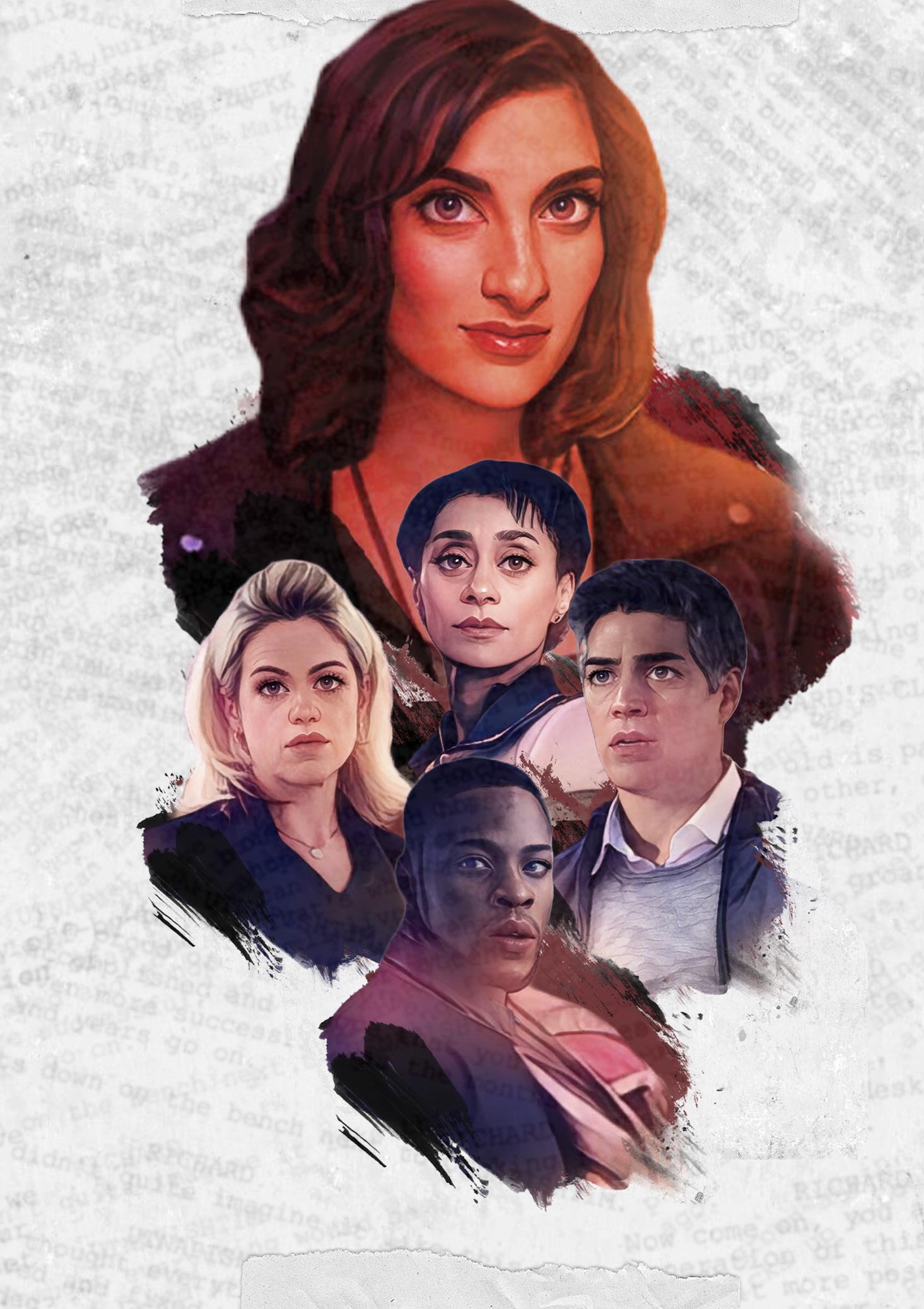





































 WIDWWA
WIDWWA



 WIDWWA
WIDWWA

















































